As the opening notes of Singapore’s national anthem Majulah Singapura echo over the Padang, a low throbbing sound can be heard growing louder high behind the main spectator stands. By the time the first stanza is finished, the source of the sound can be seen clearly by all: a Republic of Singapore Air Force’s (RSAF) CH-47SD Chinook flanked on either side by AH-64D Apache Longbows. Hanging directly below the Chinook is a large national flag of Singapore, fully deployed and streaming gracefully, its red and white colours providing a contrast to the sky. Within a minute, the aircraft trio flies parallel to the Padang before turning away, as the anthem approaches its conclusion.
Since 1970, when it was first debuted and flown by the Aérospatiale Alouette III SA316B, the State Flag Flypast has been an iconic highlight of every National Day Parade (NDP). In 1980, the Bell UH-1H Huey took over the flag flying duties, and the Eurocopter AS332 Super Puma succeeding it in 1986. By then, the flag had being increased in size to a huge 60 by 90 feet, which set a then-world record for the largest state flag to be flown. From 2001, the Boeing CH-47SD Chinook of 127 Squadron has being undertaking this important role. While the sight of the flag in the sky provides a breathtaking sight for the spectators, behind the scenes a group of RSAF personnel have put in many hours of sweat and tears to prepare it for its flypast.
The Team
While 127 Squadron provides the air crews and Chinooks for the flag flypast, a core team of RSAF regulars have been assembled after last year’s NDP to prepare for this year’s flypast. The flag team, or formally known as the Mustang Presidential Flag Salute Crew (MPFSC), consists of both regulars and NSmen (National Servicemen) and they undertake the inspection, preparation, launching and recovery of the flag from around May to August. This year’s MPFSC is led by Military Expert 4 (ME4) Koh Juay Boon, Flag Party In-Charge (IC), and ME3 Rodney De Souza, Second-in-Charge (2IC), both from 127 Squadron. In addition to the 20 regulars who form the core team, a new group of RSAF NSmen will be rotated through the team every two weeks as part of their in-camp training (ICT) cycle. By the time the last flag flypast takes place on 9 August this year, a total of about 500 NSmen would have been trained and involved.
The Flags
There are a total of 14 flags made of parachute nylon fabric which will be set up for the flypast, and each measures 60 x 90 feet and weighs about 700 pounds with the primary and secondary slings attached. At the end of the previous NDP season, the flags are inspected and any flags that are no longer flight worthy will be removed and new ones ordered. Every new flag is flown and visually inspected while in the sky, and its required airspeed is recorded, which can be adjusted via air pockets on its end. It is critical that the flags are calibrated to the Chinook’s airspeed, as the flag may be torn and ripped apart if it flies too fast or droop and create drag if too slow.
During the new NDP season, every flag is inspected weekly for any physical damage such as tears or fraying, and for stains or dirt. This time consuming process requires it to be unfurled and rolled back in a proper sequence after. They are then graded from 1 to 3, with the grade 1 flag being used for the NDP previews and actual day flypasts. From the NDP Previews onwards, the flags are deployed across three bases: Pulau Sudong (5 flags), Sembawang Air Base (4 flags) and Changi Air Base (5 flags). One of the reasons for this geographically separated deployment is to minimise any potential inclement weather disruption to the launching and recovery of the flag. A total of three flags will be launched into the air and at the last moment as they approach show centre, the main one will proceed while the other two will turn around and return back for early recovery.
The Rigging
Every flag has a 67 feet long primary steel cable permanently sewn into its hoist edge pocket. During preparation for rigging, a 136 feet long secondary cable is threaded through this pocket manually, while an additional 67 feet long cable is shackled to the upper end of the primary cable. The two bottom ends are shackled and attached to three groups of three cables each, with a 500 pound ballast weight each shackled to a each group.
At the top, the two ends are shackled to an additional 5 foot cable and a sling webbing with shackle ends. Each shackle in the rigging is secured with a bolt and nut, with split pins that will prevent the nut from dislodging. This form of rigging for each flag ensures that in the event of a connection failure, there are redundancies which will take up the slack and still hold the flag securely in position for the flypast. Each fully rigged flag will weigh in at 2750 pounds.
The Aircraft
For each flypast, three Chinooks and three Apaches will be launched, to provide redundancies in case an aircraft or flag has a situation which prevents it from proceeding towards the parade for the flypast. The Chinooks also undertake early additional missions to ferry the MPFSC personnel, flags, and supplies in waves to Pulau Sudong and Changi Air Base. Close scheduling and coordination ensures each flight is maximised and to prevent flight crew fatigue. Inclement weather will also affect flights, and while the team endeavours to ensure that a flag flypast will be carried out, aircraft and crew safety are ultimately still the key factors in the event of a non-deployment.
The Mission Begins..
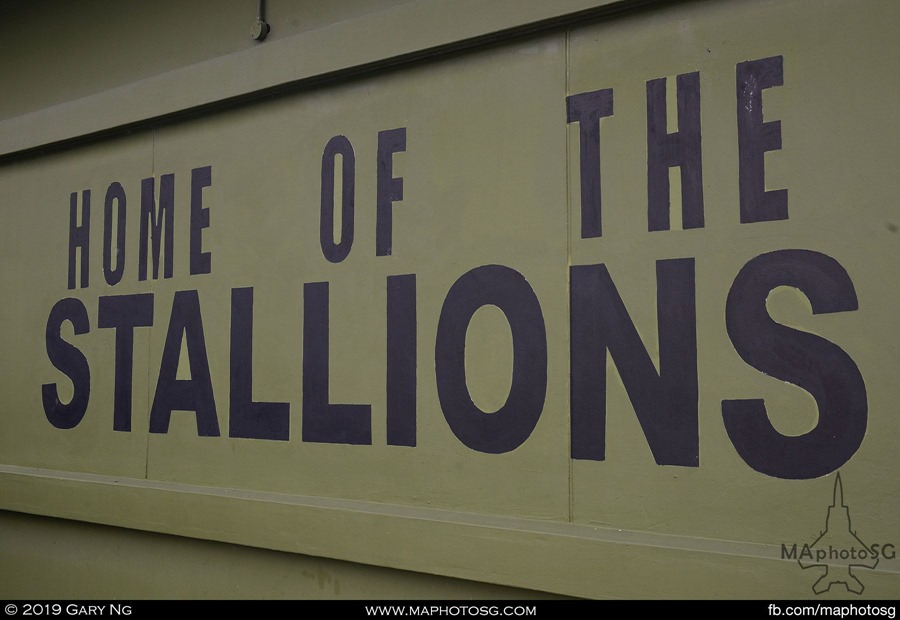
1. 127 Squadron at Sembawang Air Base will be the location from which the MPFSC team will be based at for the NDP season.
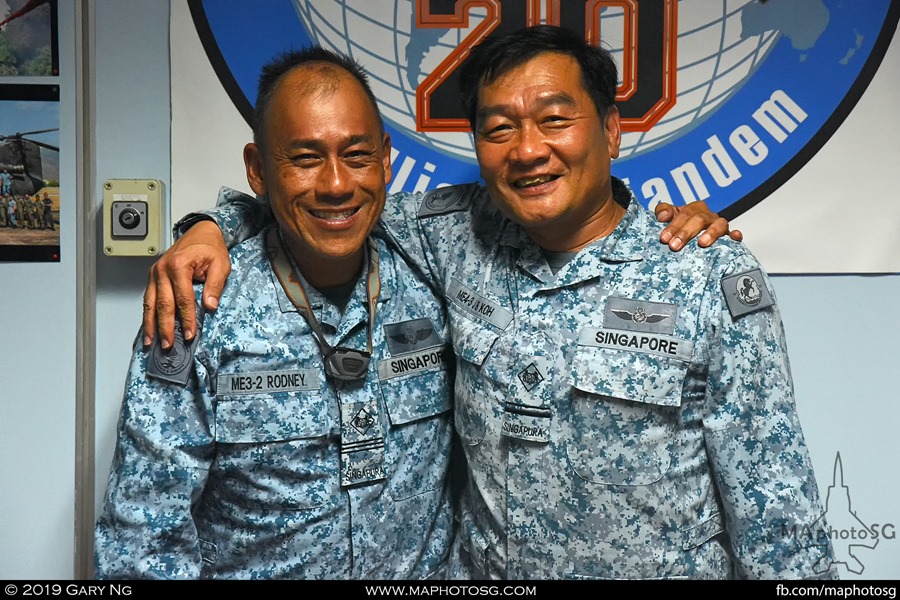
2. ME4 Koh Juay Boon, Flag Party IC (right) and ME3 Rodney De Souza, 2IC (left) lead the Mustang Presidential Flag Salute Crew (MPFSC) for NDP 2019.
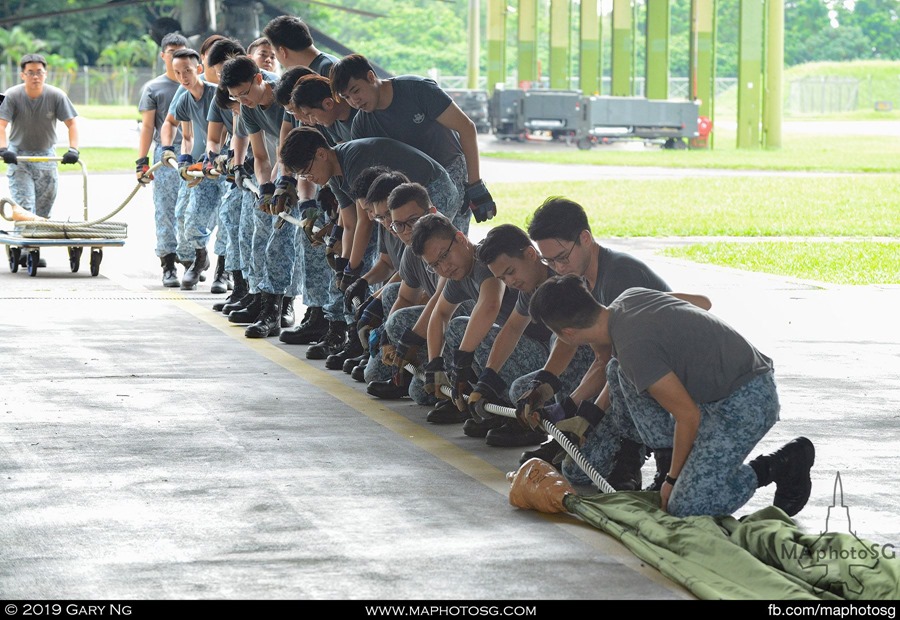
3. During the week, the NSmen from MPFSC team will practise the flag rigging procedures to familiarise themselves and to ensure that it is carried out safely and securely.
Here the 136 feet secondary cable is threaded through the hoist edge pocket.
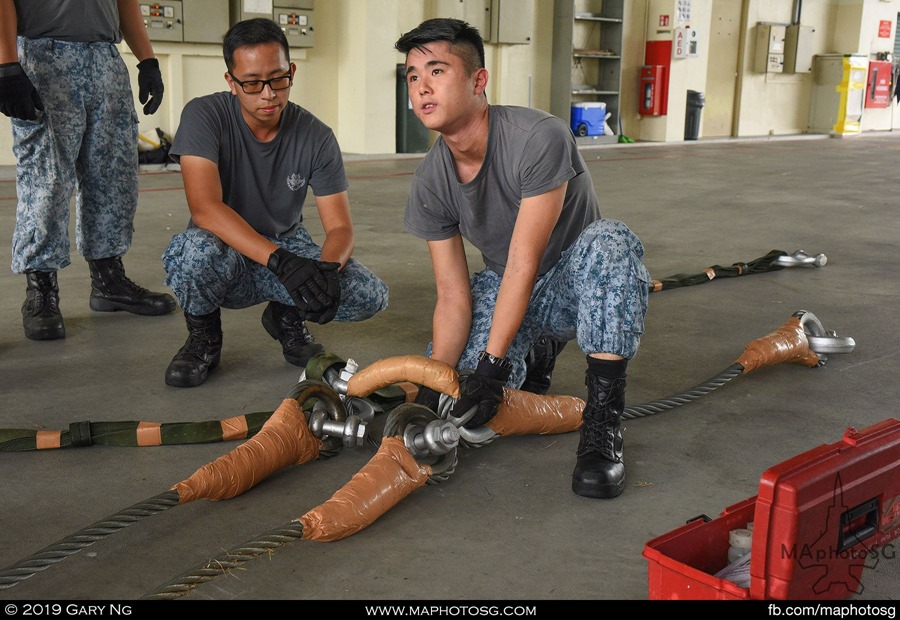
4. Rigging training is conducted by the core team crew, who have many years of experience being involved in State Flag Flypasts.
Shown above are the top ends shackled together with an endless, and attached to a 5 feet cable and a webbing sling.
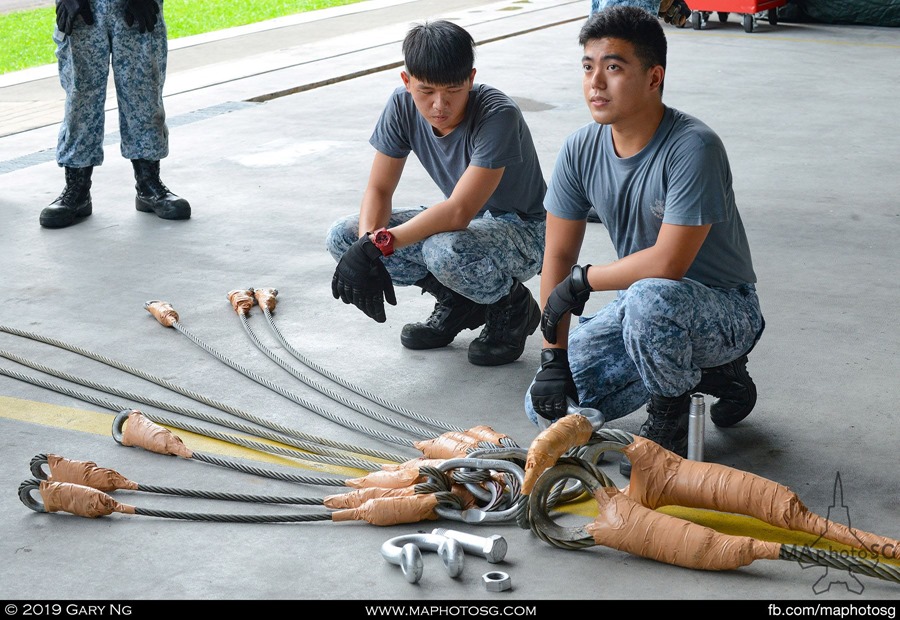
5. The bottom ends will be shackled to three groups of three cables. Each 500 pounds ballast ball will be secured to three cable ends each.
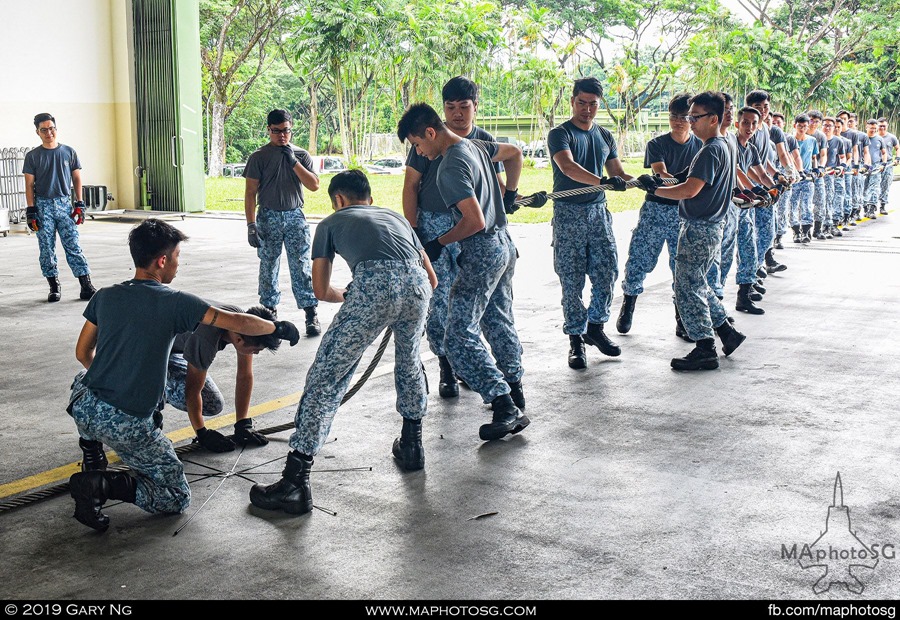
6. After the 136 feet secondary cable is rigged, the extra length is coiled up to allow for easier transportation and storage.
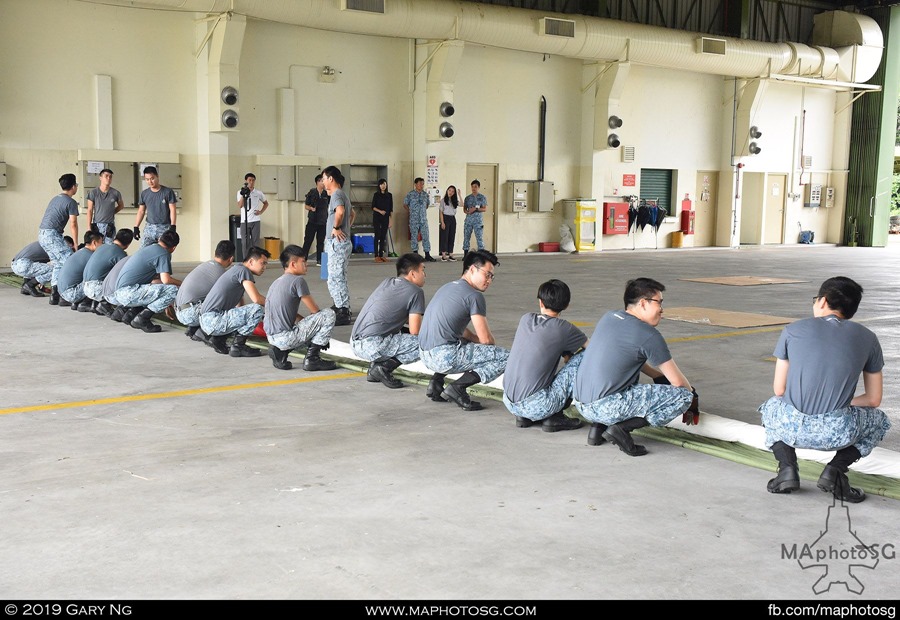
7. After coiling, the rolled up flag is placed in position in preparation for unfurling for the inspection process. Each flag requires about 25 men for this process.
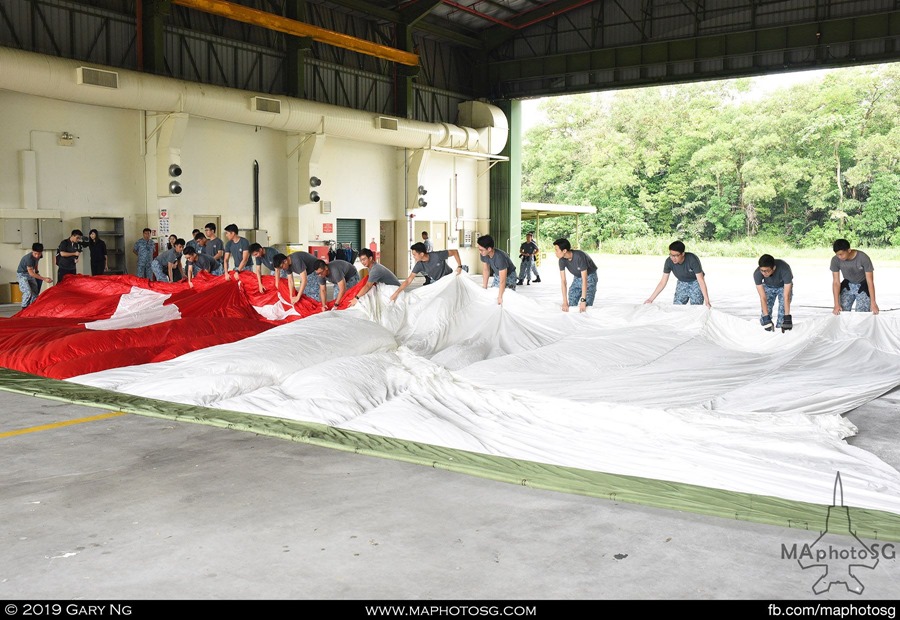
8. The unfurling is performed carefully to ensure that the flag is not subjected to any physical damage.
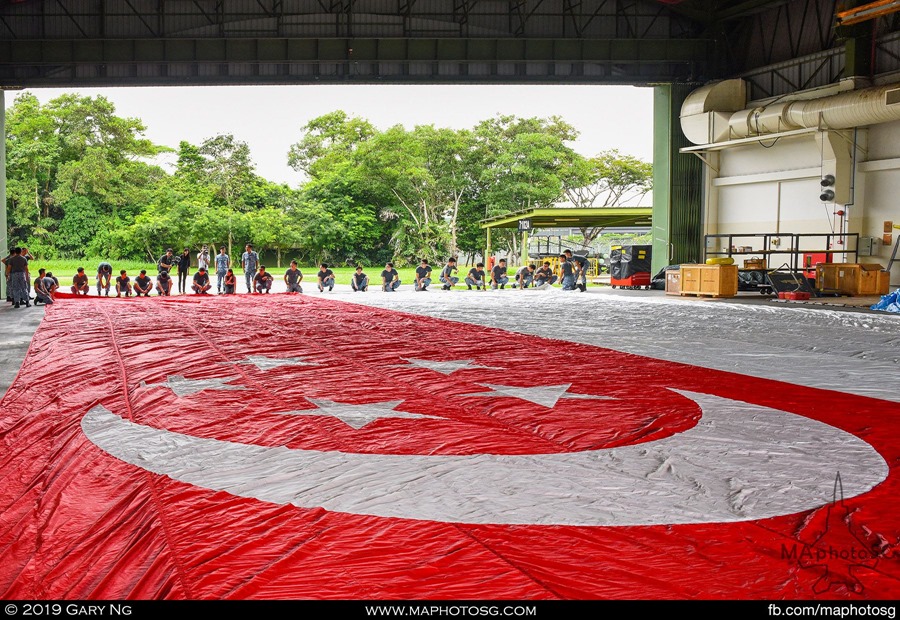
9. Fully unfurled, the flag is prepared for physical inspection.
The flag is visually inspected for any damages such as tears or fraying, or stains, through a time intensive manual process.
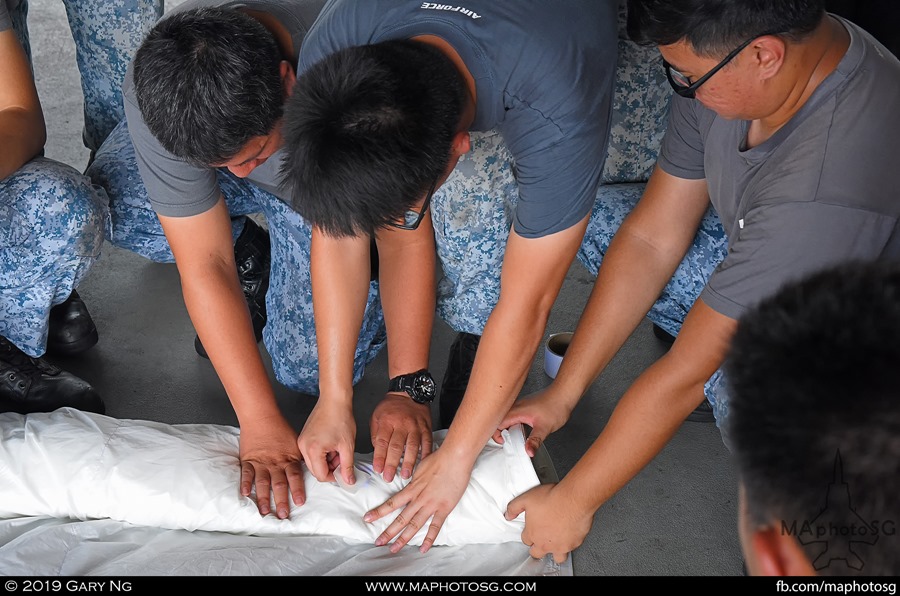
10. In the case of small tears, a special fabric repair tape will be used to patch it.
For stains, cleaning chemicals will be used to remove it, with a need to ensure that the fabric layer is not cleaned too deep to prevent any fraying.
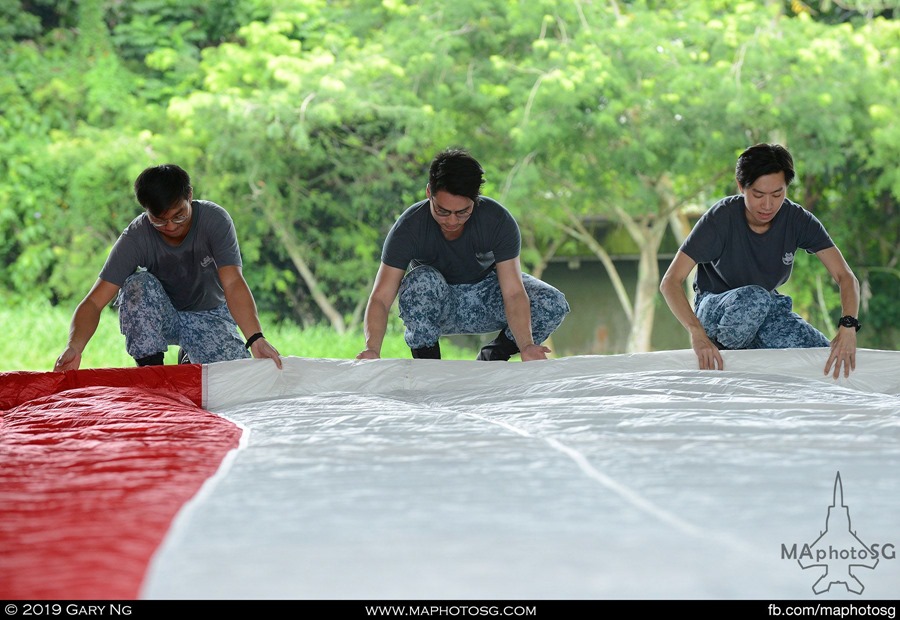
11. Once the inspection process is completed, the rollup process begins. For every few rolls, the men will perform a tuck which pulls the rolls tightly.
After that, the end point men will perform a pull which straightens out the roll. These steps will be repeated a few times during the rollup process.
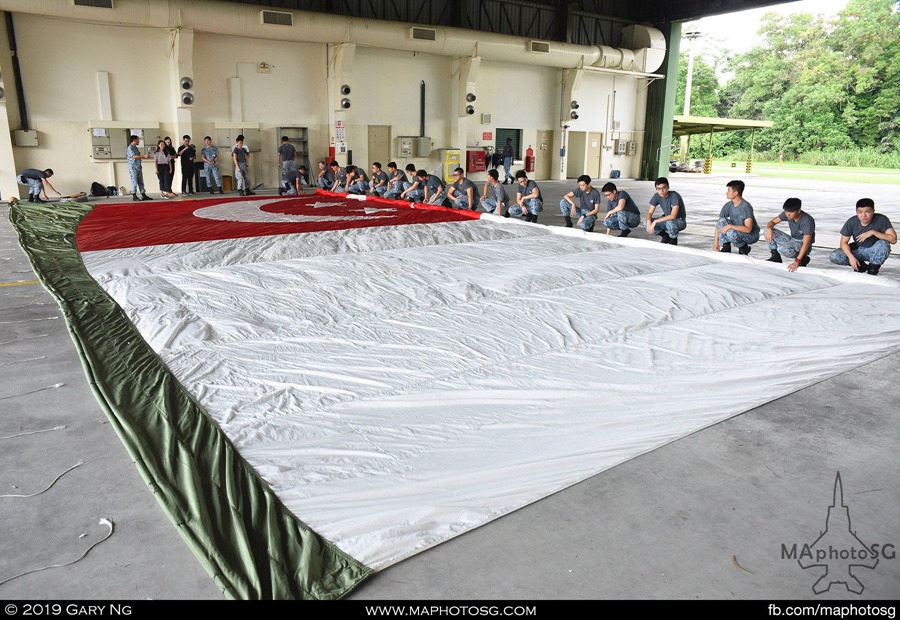
12. The entire rolling process will take 25 men about an hour to complete, while squatting or kneeling throughout.
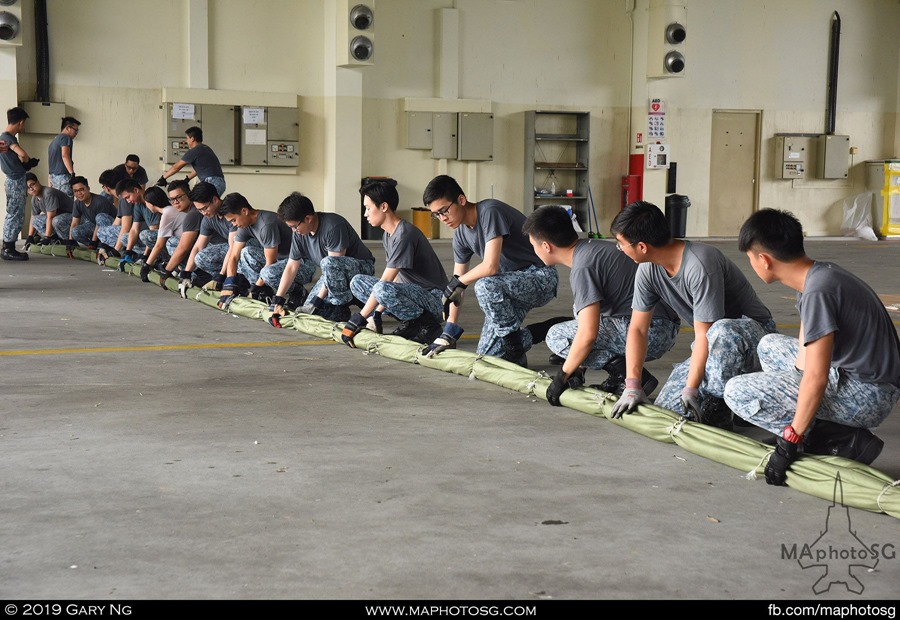
13. Once rolled up, the flag is secured with strings in preparation for loading.
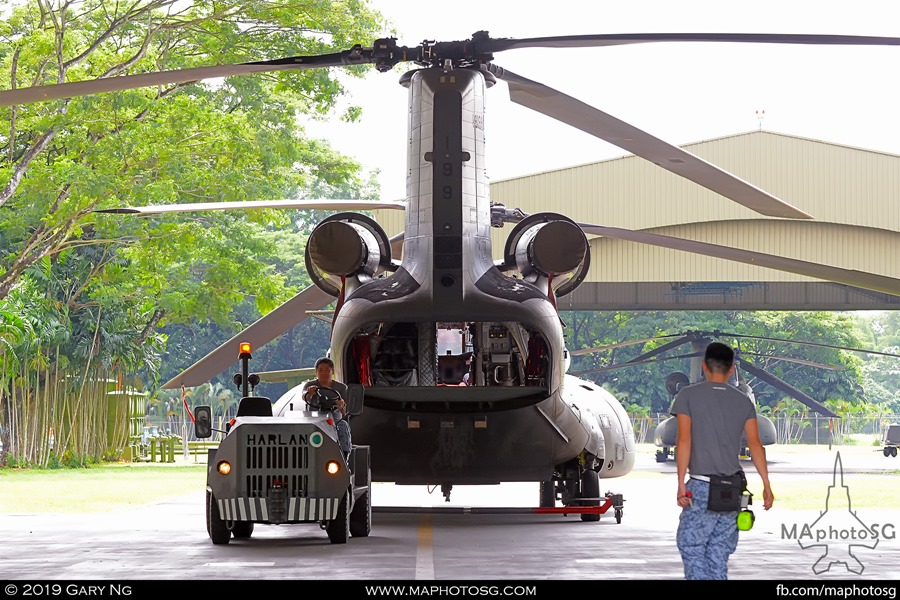
14. With the hangar cleared, a CH-47SD Chinook is towed in prepration for the dry loading of the flags.
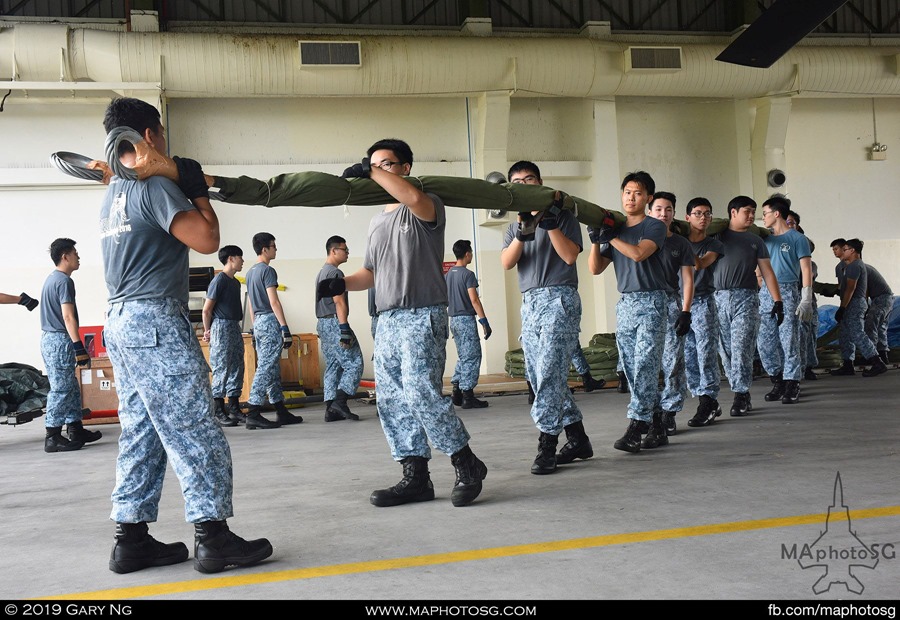
15. The flags will be loaded manually into the Chinook.
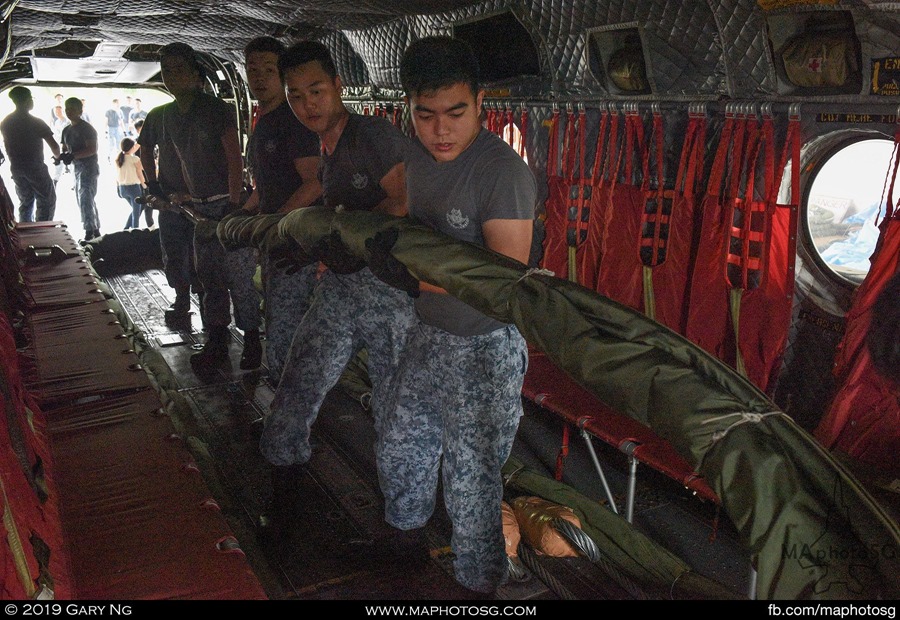
16. Each flag with its cables has to be coiled properly and securely within the limited deck space of the Chinook.
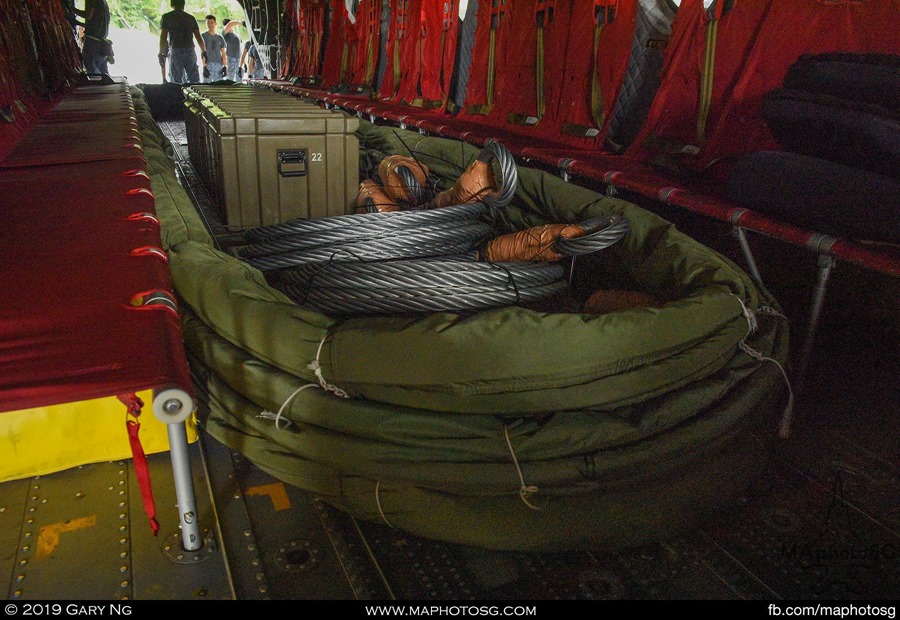
17. The Chinook will have to make two trips to bring the flags to Pulau Sudong. For the first wave, it will carry three flags and supporting equipment.
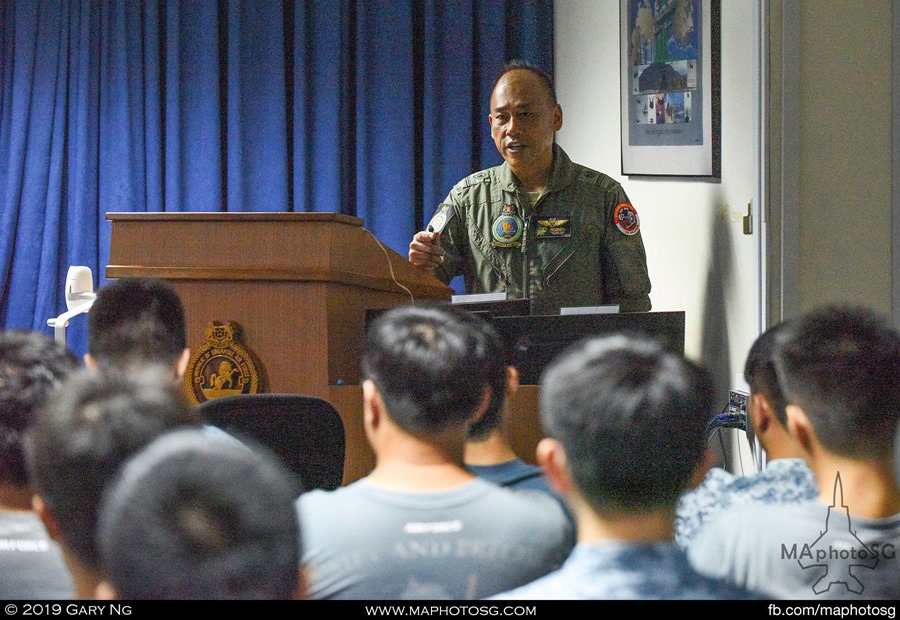
18. ME3 Rodney De Souza gives the mission and safety brief to the team that will be deployed to Pulau Sudong the next day.
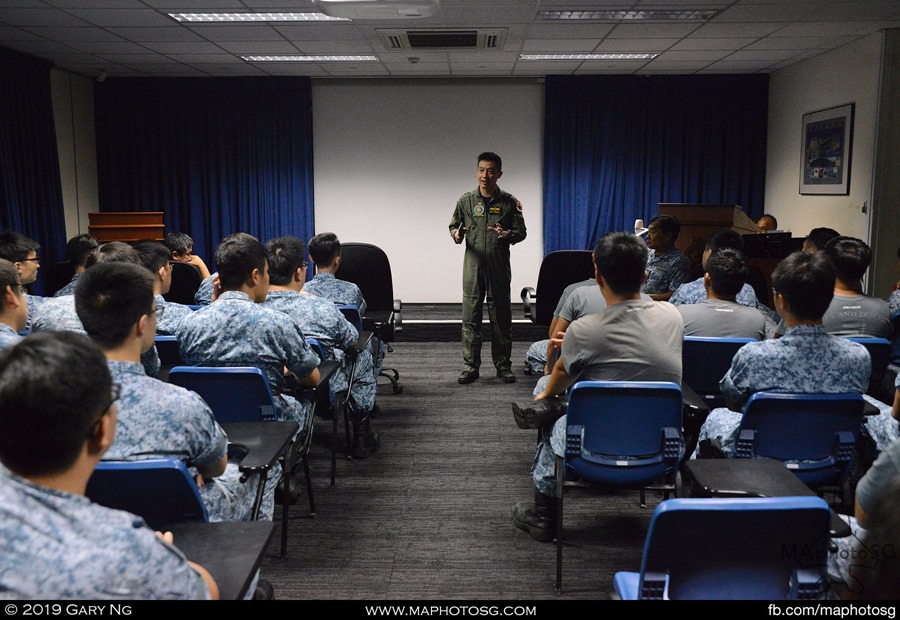
19. Lieutenant-Colonel (LTC) Ryan Low, Commanding Officer, 127 Squadron, speaks with the team at the end of the briefing.
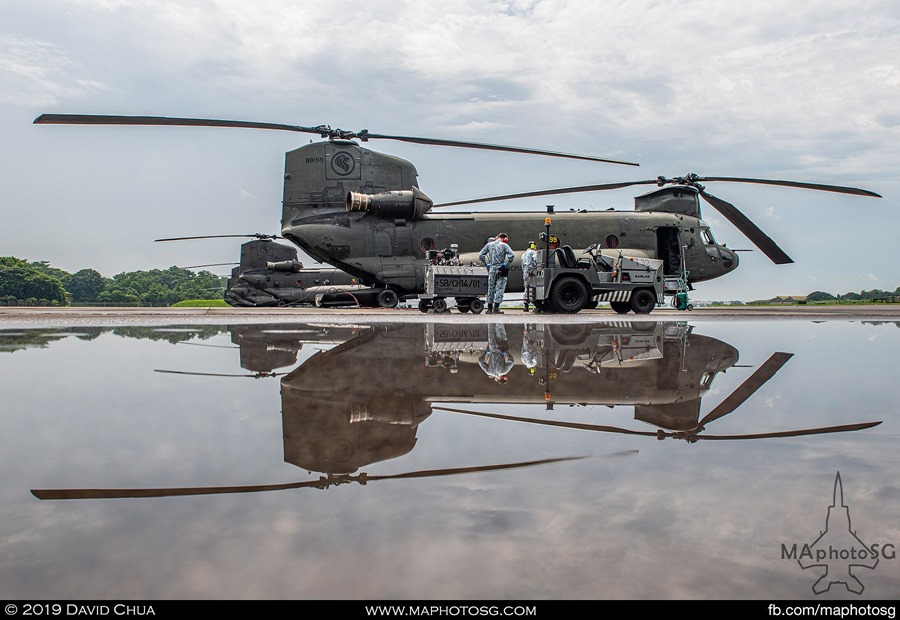
20. Mission start time: 1100 hours.
On deployment day, the loaded Chinook is towed out to prepare for pre-flight checks.
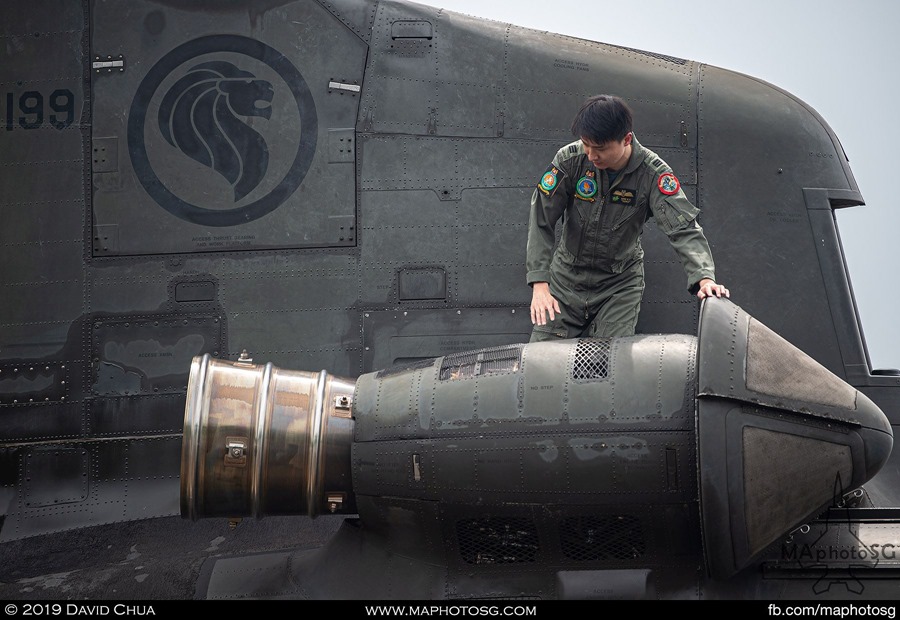
21. The pilots performed a physical pre-flight check of the Chinook.
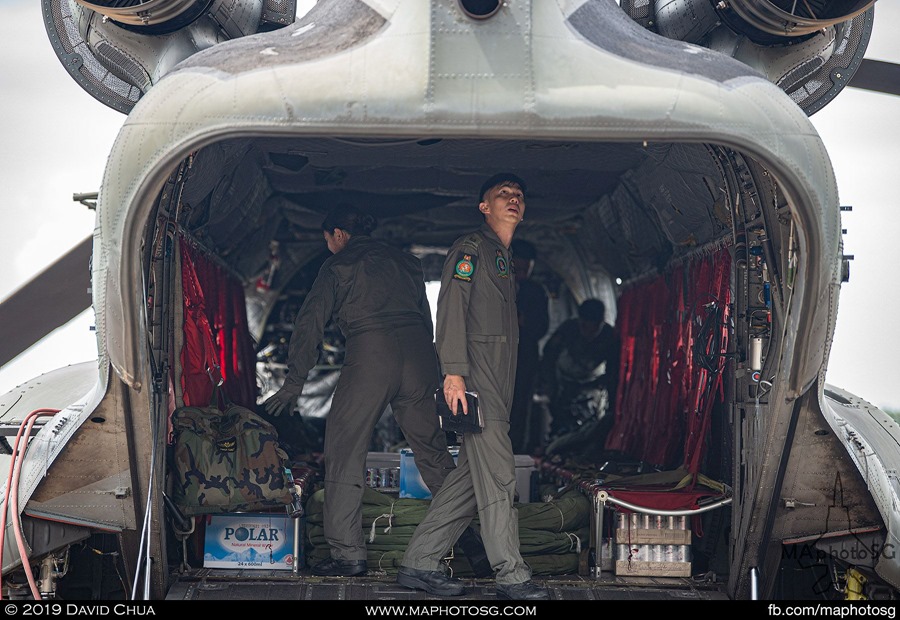
22. The crew inspects and ensures all the cargo are strapped down securely and there are no physical issues in the interior.
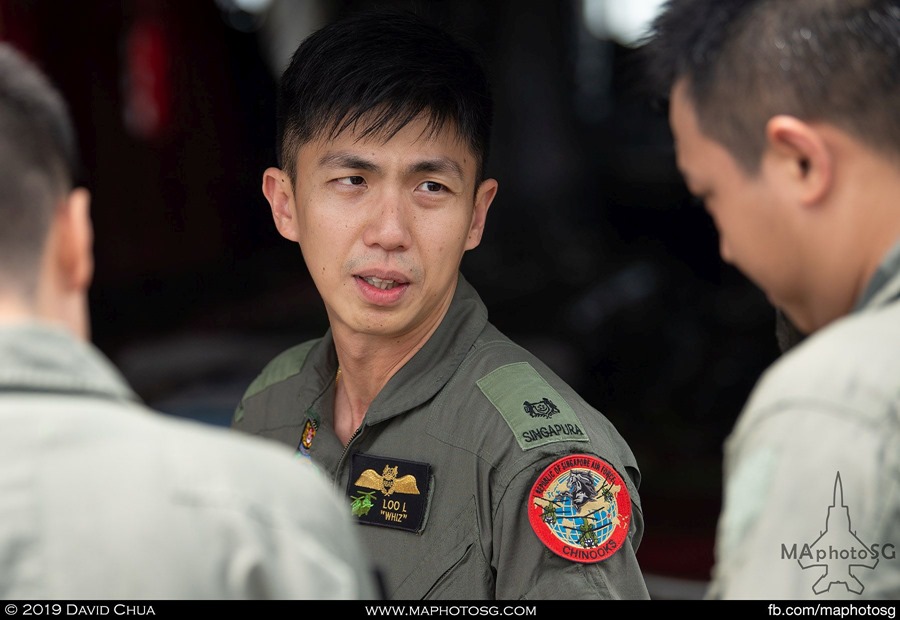
23. A pre-flight briefing is conducted by the crew to finalise the flightplan schedule and any contingency plans.
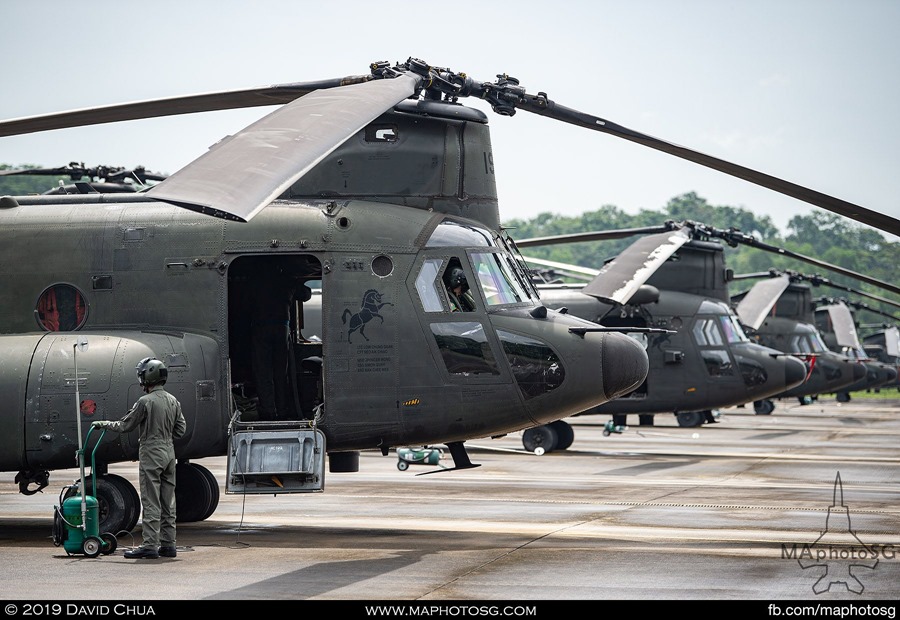
24. The pilots prepare to start the Chinook upon completion of the pre-flight checks.
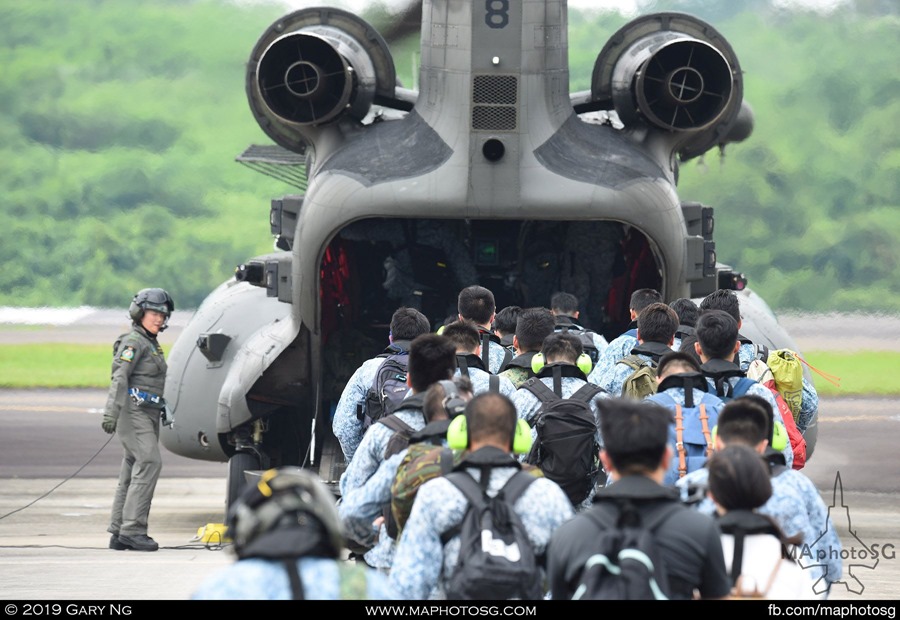
25. The first wave of the team make their way to the Chinook for the short flight to Pulau Sudong.
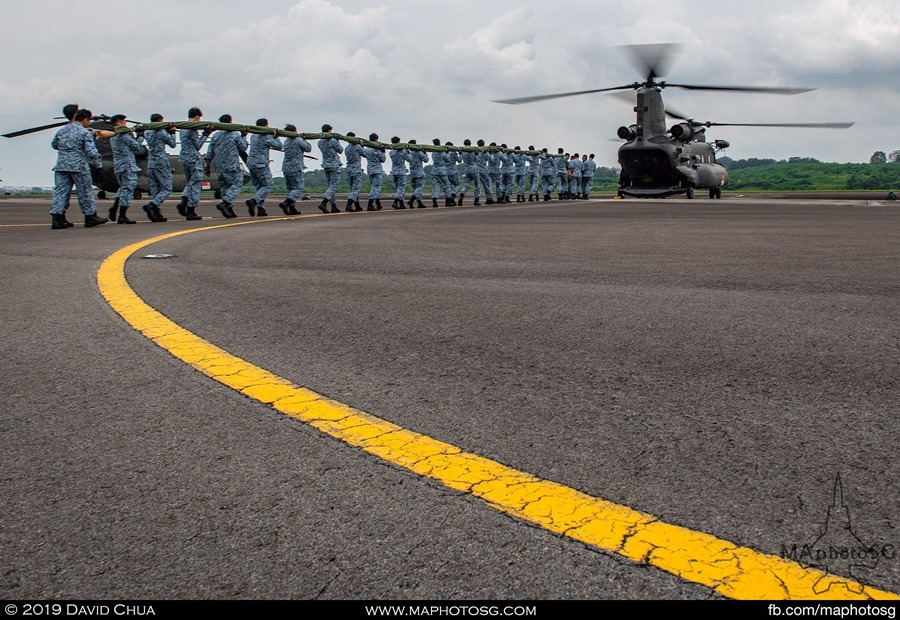
26. After depositing the first wave, the Chinook returns back to Sembawang Air Base, and the fourth flag is hot loaded along with the second wave of the team.
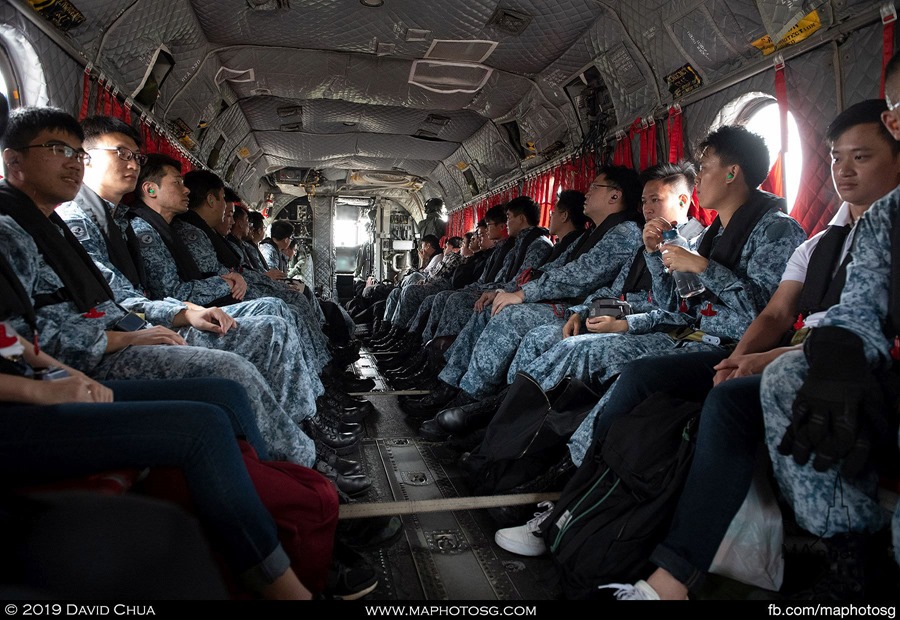
27. It takes about 10 minutes to fly from Sembawang Air Base to Pulau Sudong.
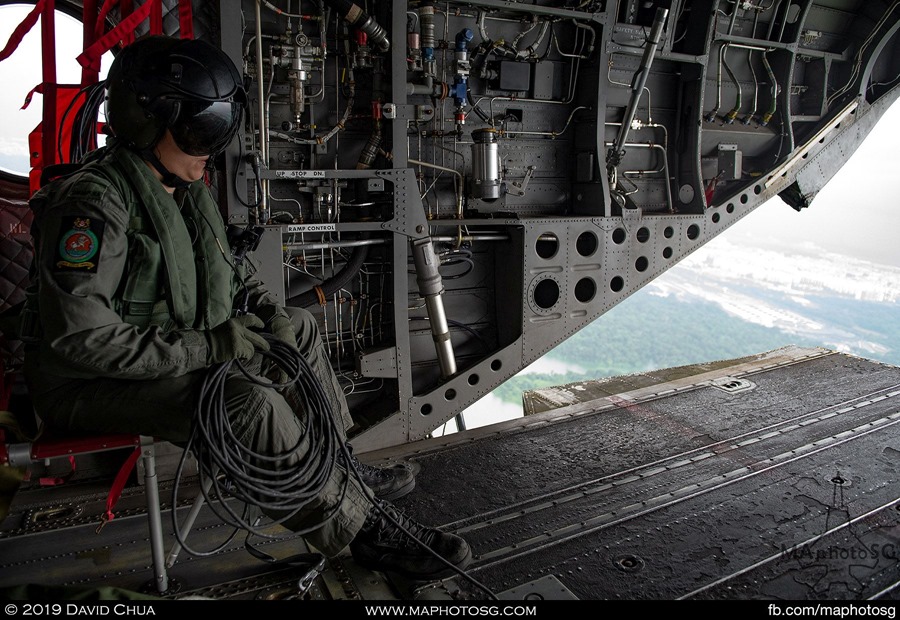
28. The Flight Engineer helps to ensure the safety of the passengers and cargo, and also acts as the additional eyes and ears of the pilots.
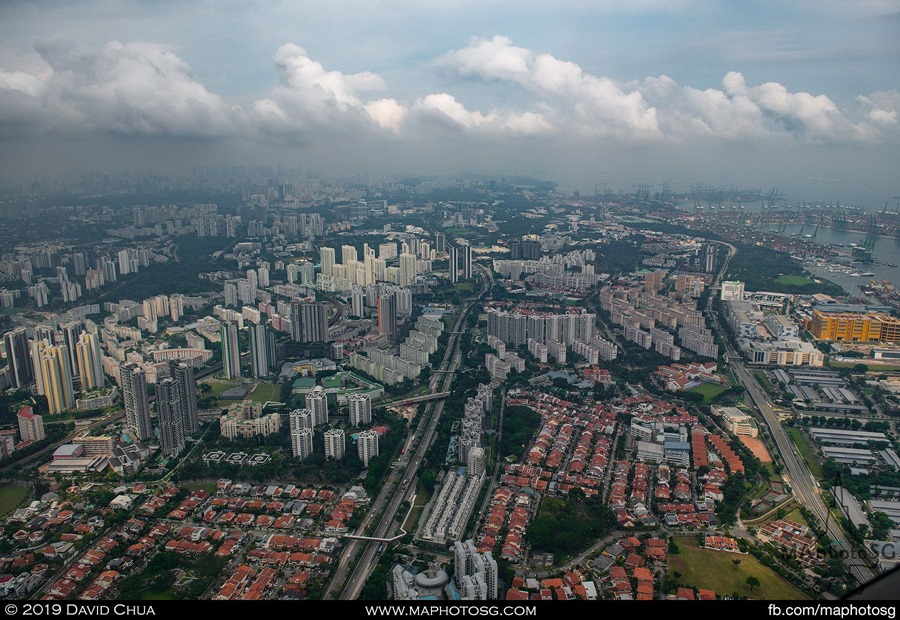
29. A bird’s-eye view of the mainland from the Chinook.
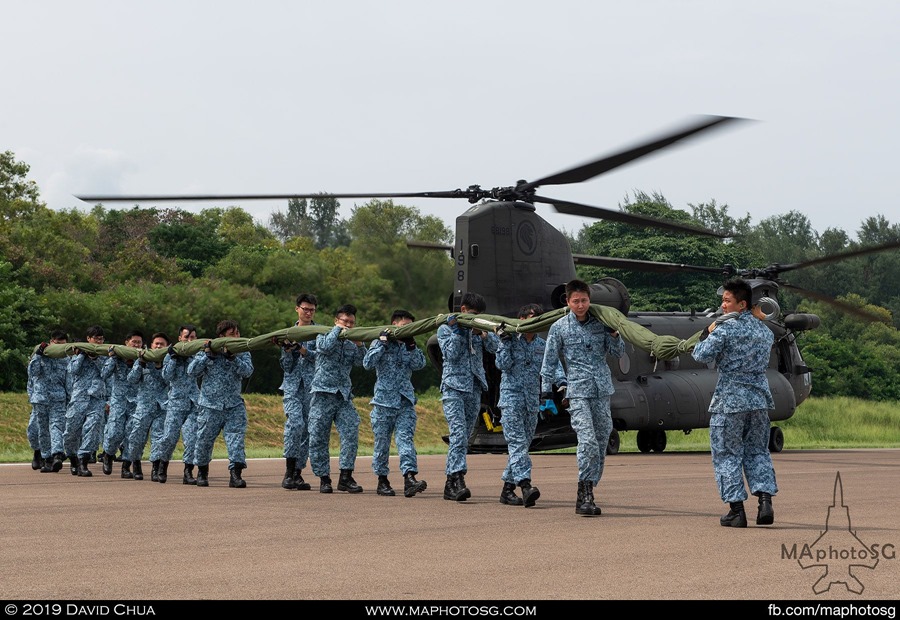
30. Once on the ground at Pulau Sudong, the second wave team performs a hot unloading of the flag and equipment.
Meanwhile, the first wave team has begun the rigging process for the first three flags.
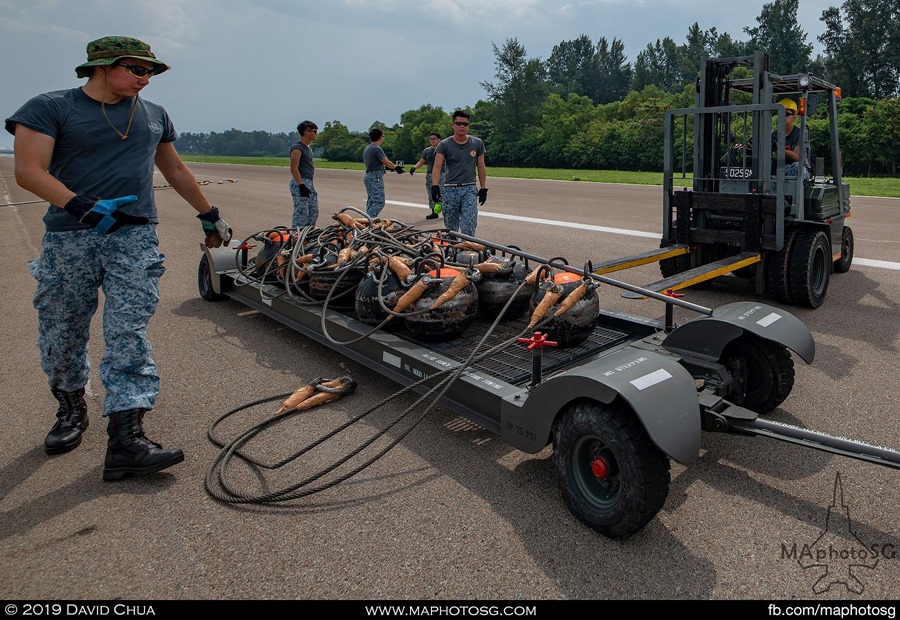
31. Each ballast ball weighs 500 pounds, and the forklift will lift and transport them individually.
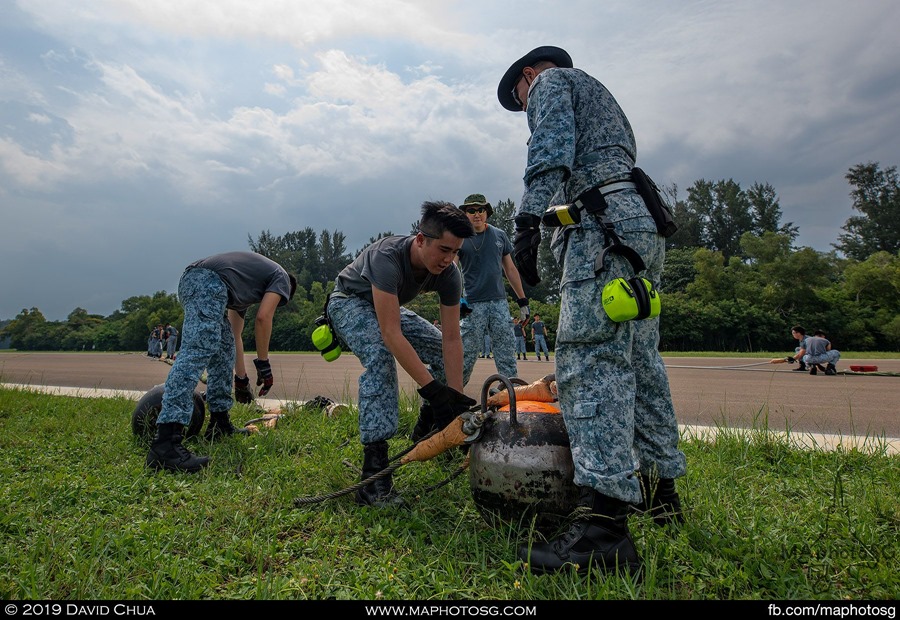
32. At the lower end of the flag, the team starts to rig the three ballast balls.
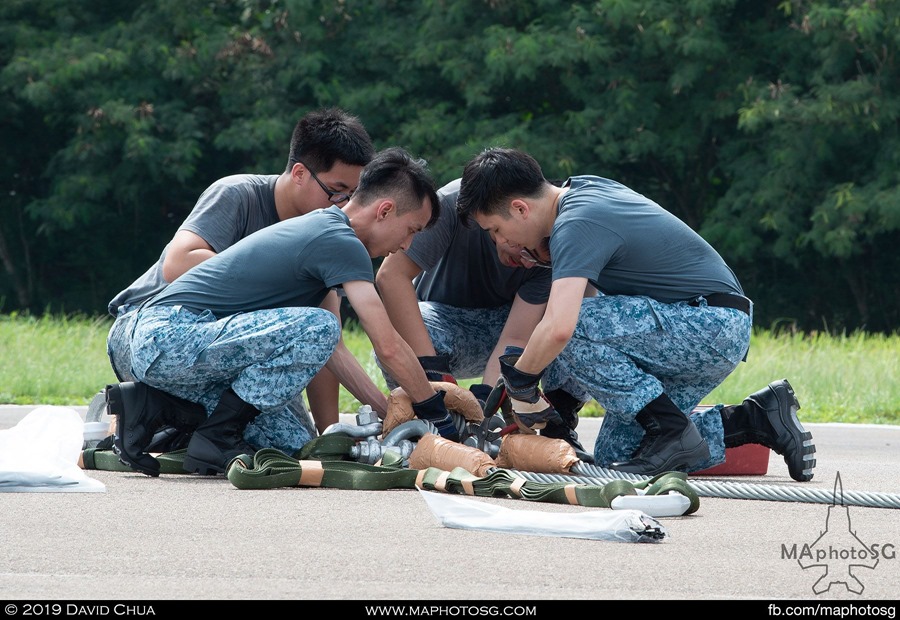
33. Meanwhile, the team rigs the top end of the flag simultaneously. All the flags brought to Pulau Sudong have to be rigged.
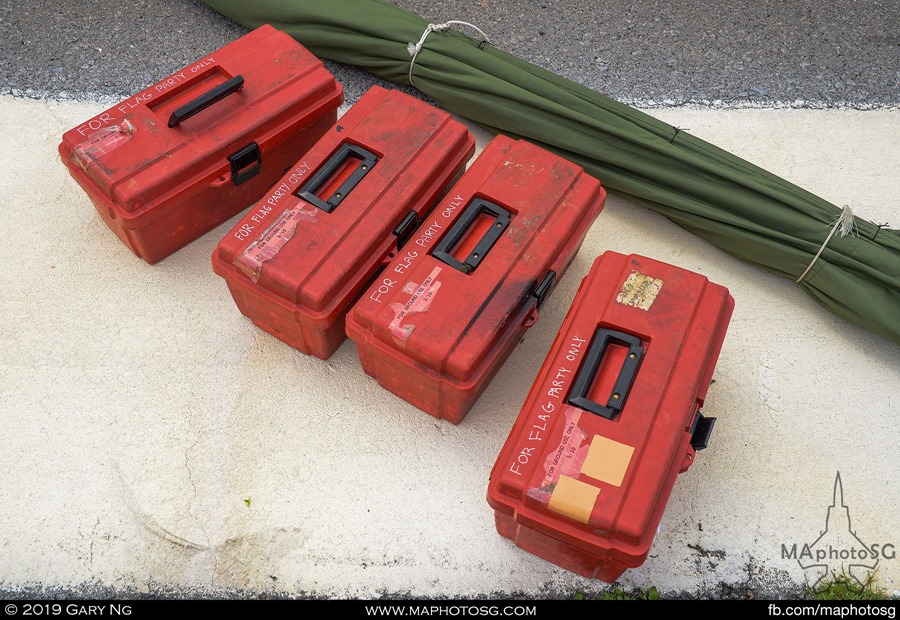
34. These tool boxes contain the necessary rigging tools such as plier wrenches, split pins and tapes.
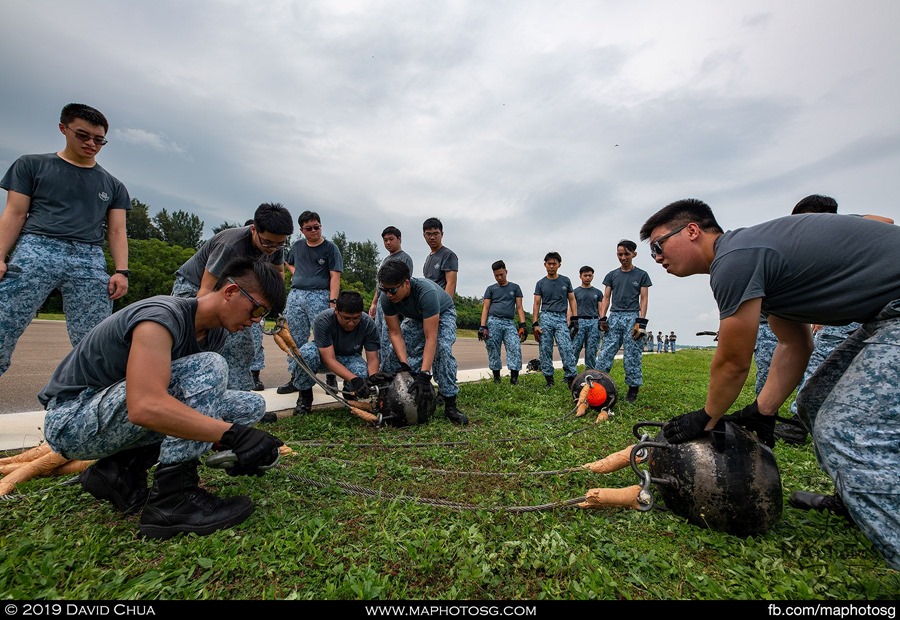
35. The team has to work against the clock to fully rigged all four flags securely and safely, with each completed flag weighing 2750 pounds.
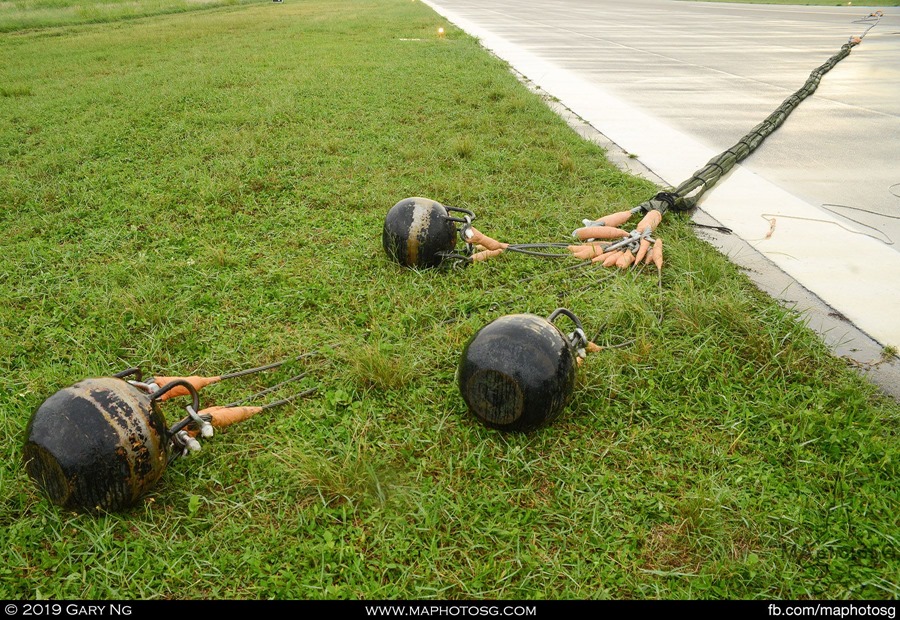
36. Completed ballast rigging. A securing webbing wraps the flag, which when pulled, will allow the flag to be unfurled.
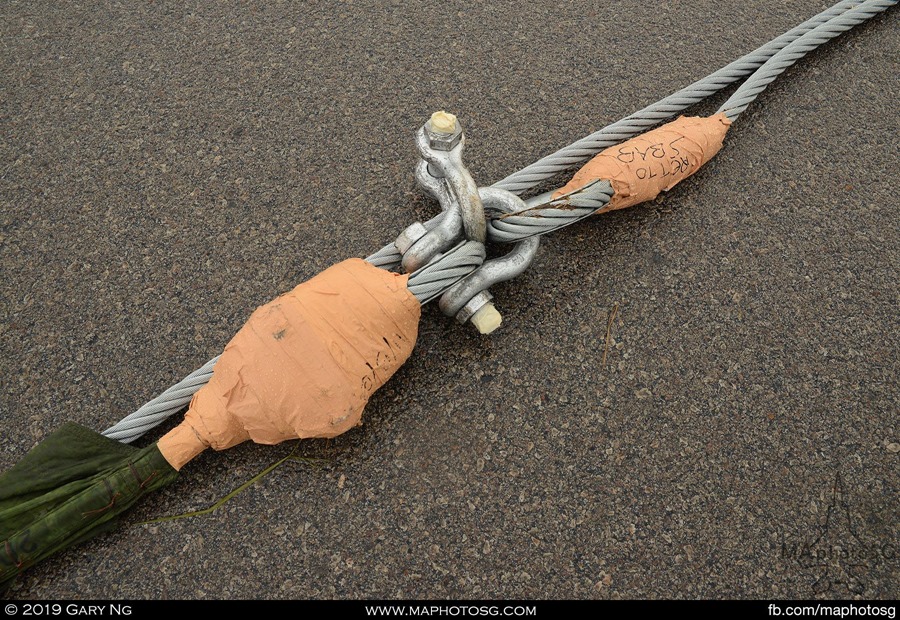
37. Completed primary cable rigging.
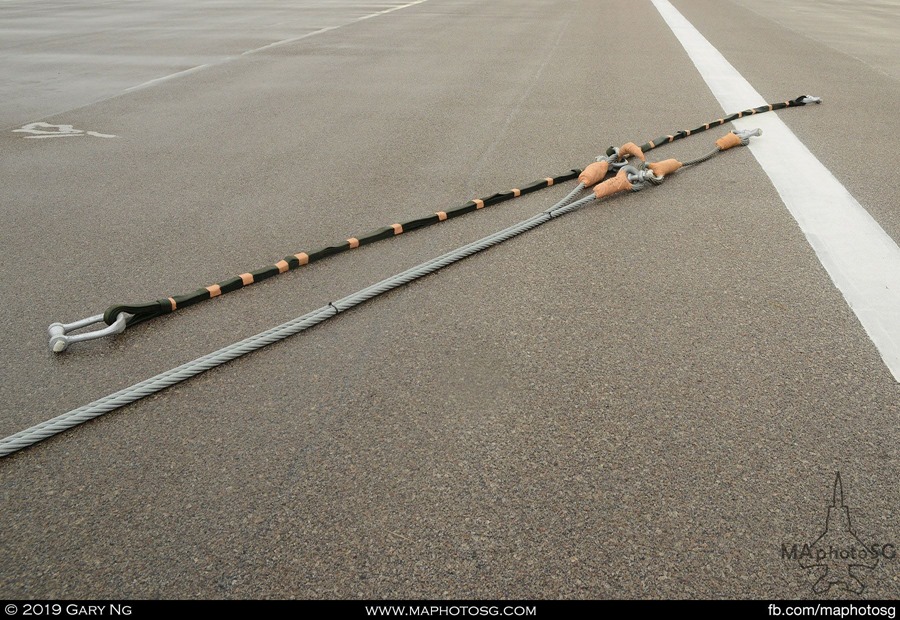
38. Completed top end rigging. The flag will be secured to the Chinook via three shackles.
In the event of a main shackle failure, the two webbing shackles will take up the slack and hold the flag in place.
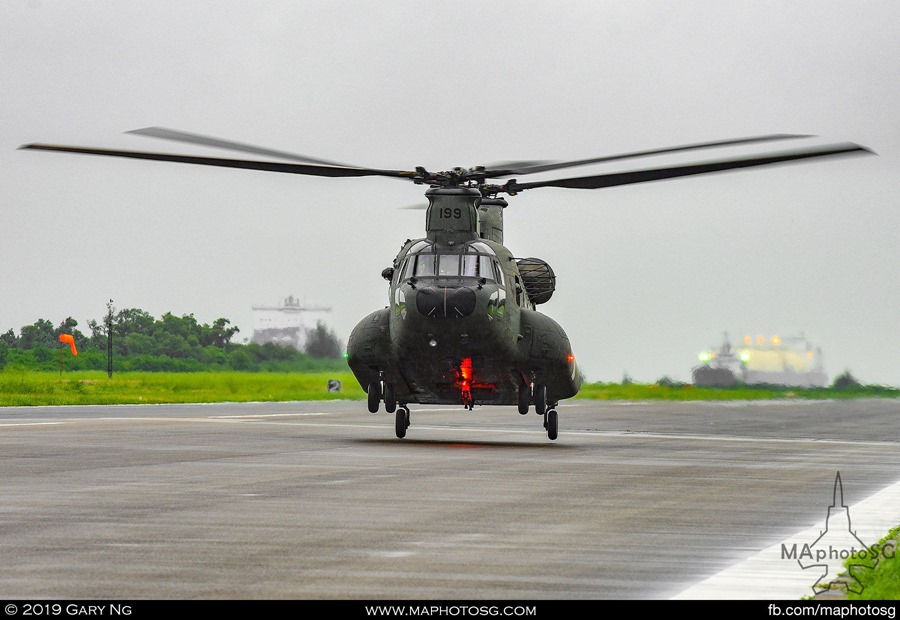
39. The Chinook comes in for a landing, and taxi to the first flag in preparation for hook up.
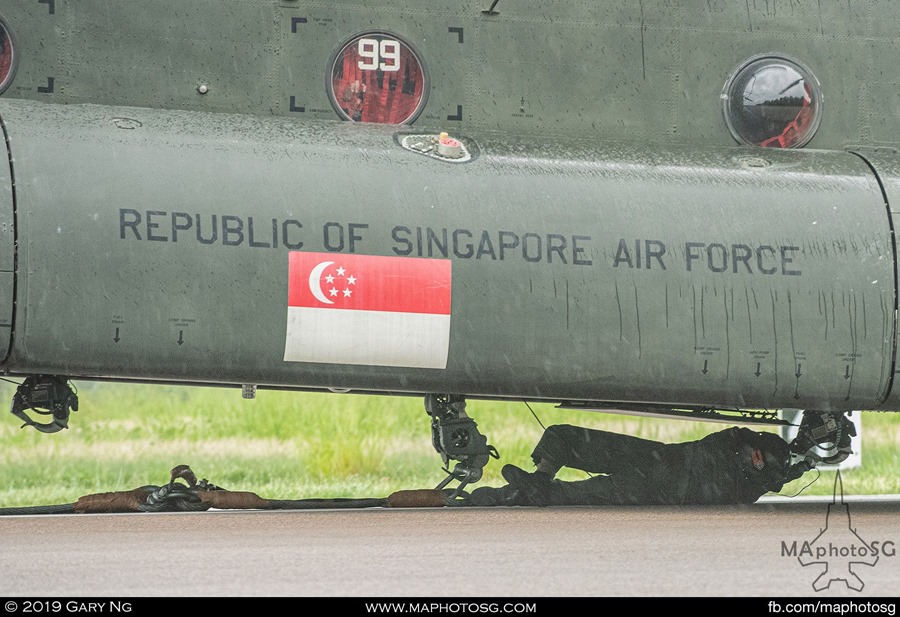
40. The Air Crew Specialist proceeds to hook up the flag once he checks them.
The main shackle will be attached to the centre main cargo hook, while the webbing shackles wil be attached to the forward and rear hooks.
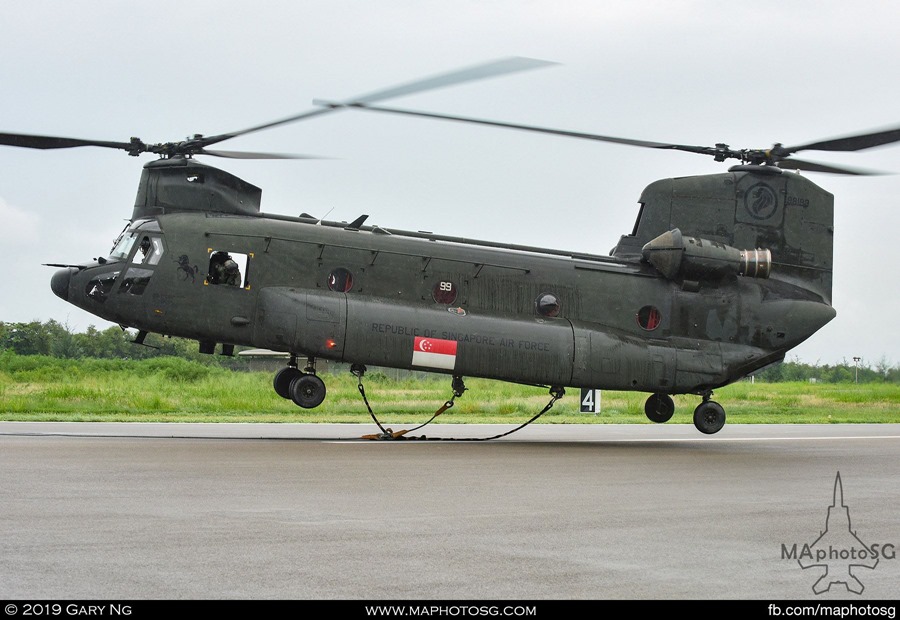
41. The Air Crew Specialist keeps a look out as the Chinook prepares to lift up the flag.
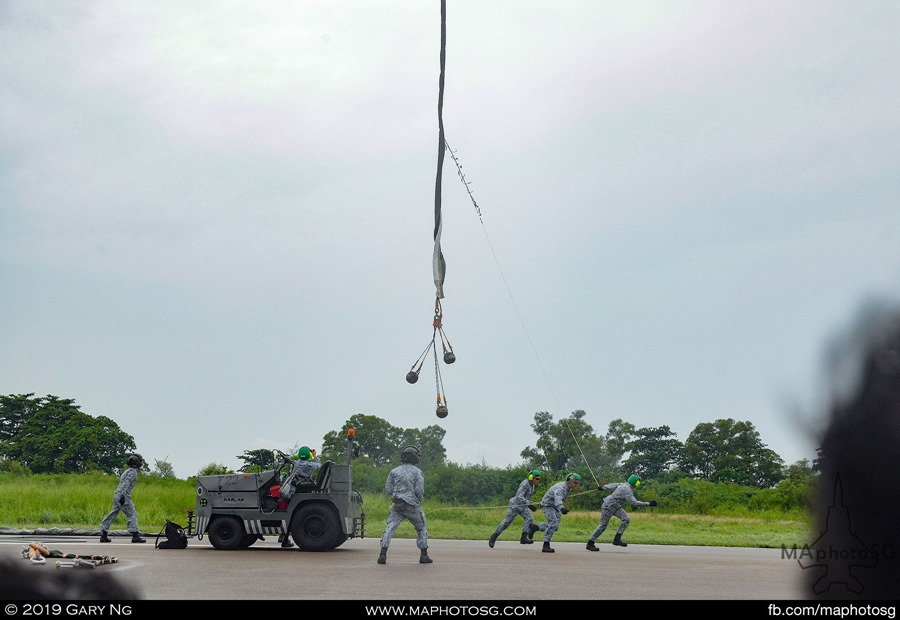
42. Once the flag is fully hoisted, the team proceeds to pull the cord that releases the securing webbing as the Chinook picks up speed and moves forward.
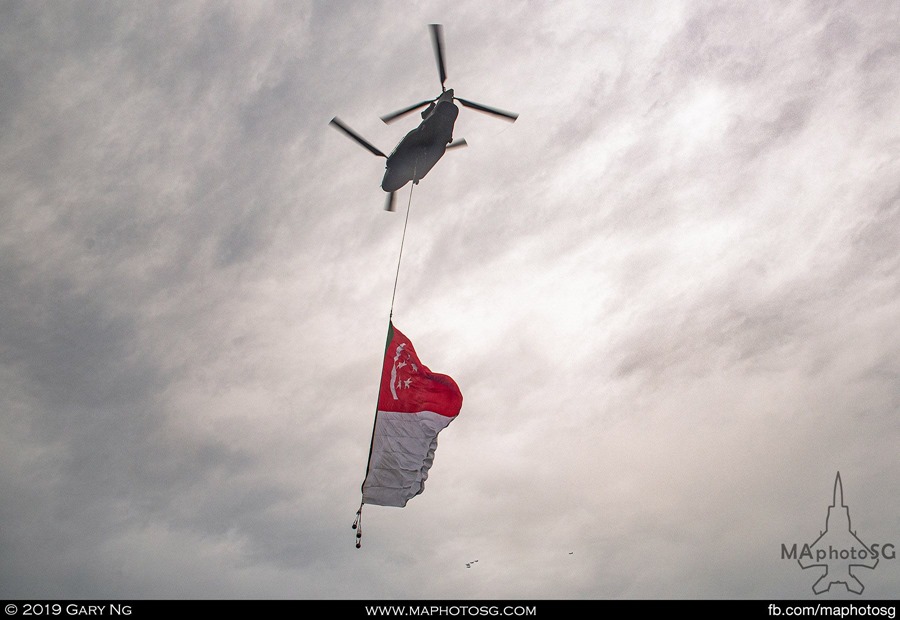
43. At the appropriate speed, the flag will fully unfurl and stream gracefully as the Chinook procceds to the rendezvous point with the Apaches.
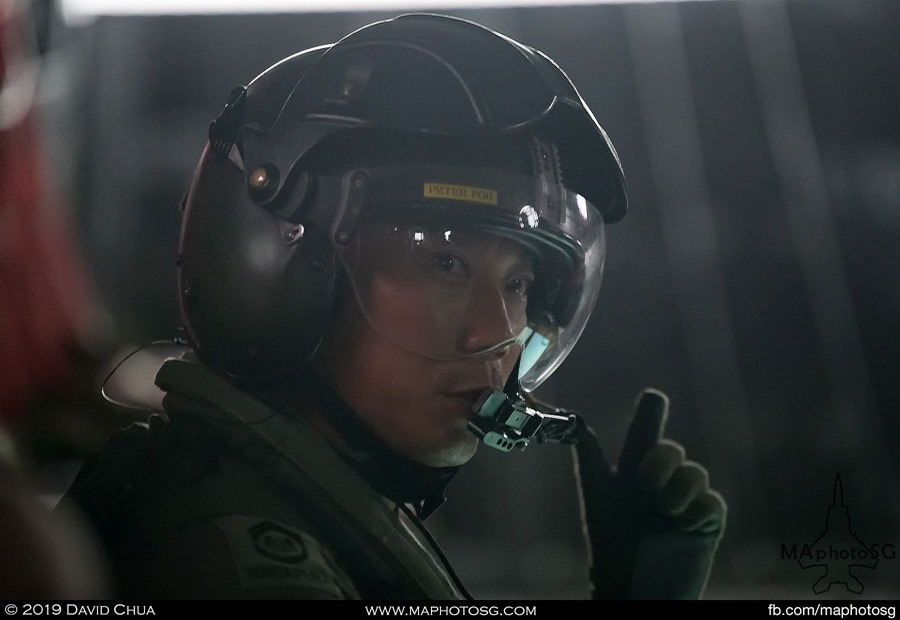
44. During the flight, the Air Crew Specialists monitor the flag and keeps the pilots updated on its status.
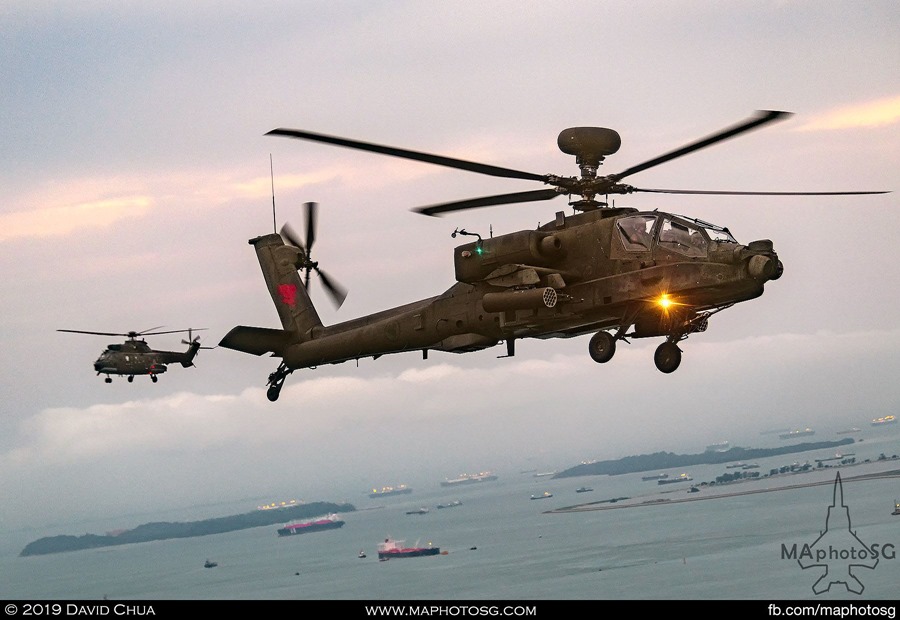
45. With a Super Puma observing in the background, an Apache forms up with the Chinook in prepration for the run-in to the Padang.
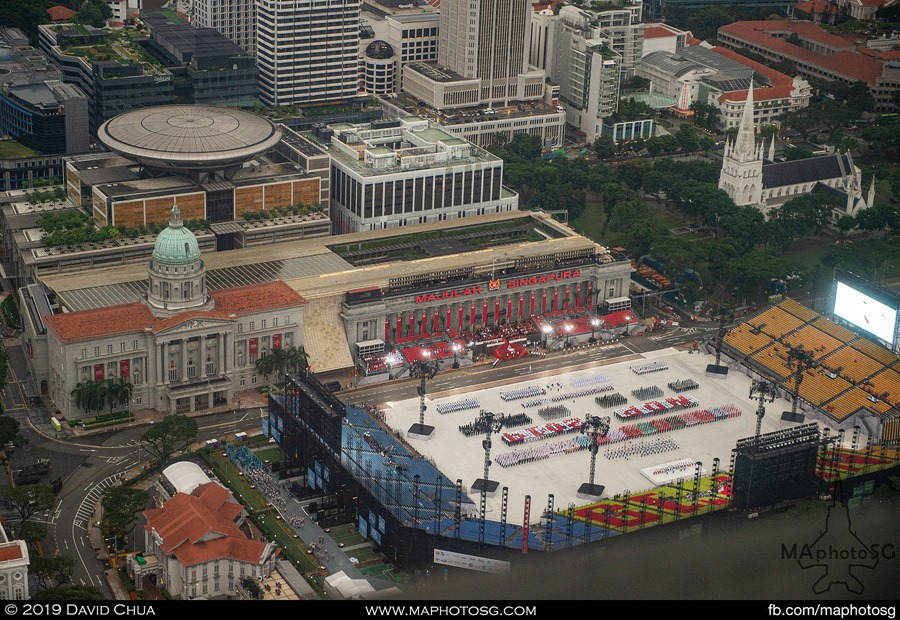
46. The State Flag Flypast begins as the national anthem begins after the President’s arrival.
Despite this being a rehearsal, the timing is still very much on schedule as the actual day.
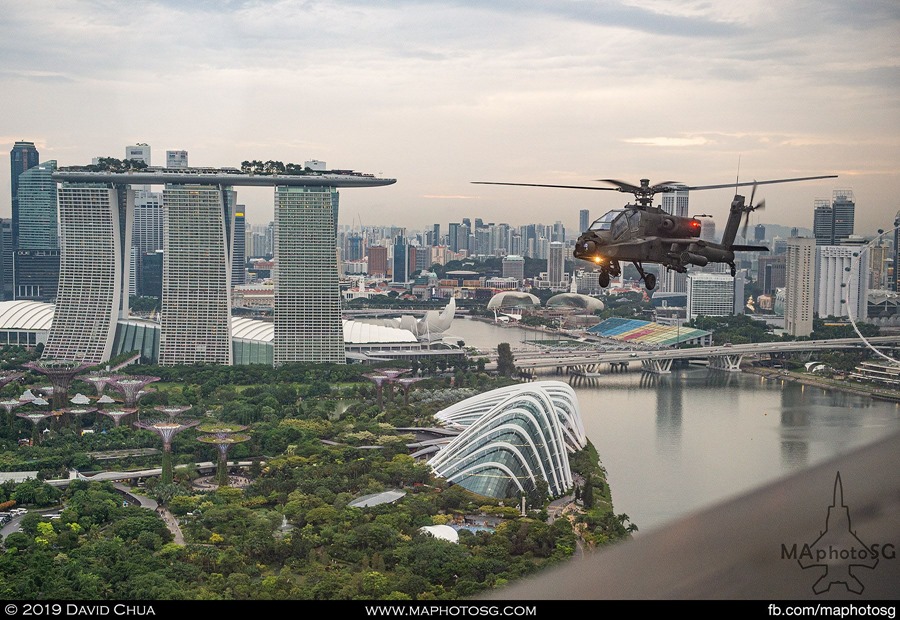
47. After the flypast, the three helicopters will turn back to the west, where the Chinook will then proceed to Pulau Sudong for the flag recovery, with the Apaches returning back to Sembawang Air Base.
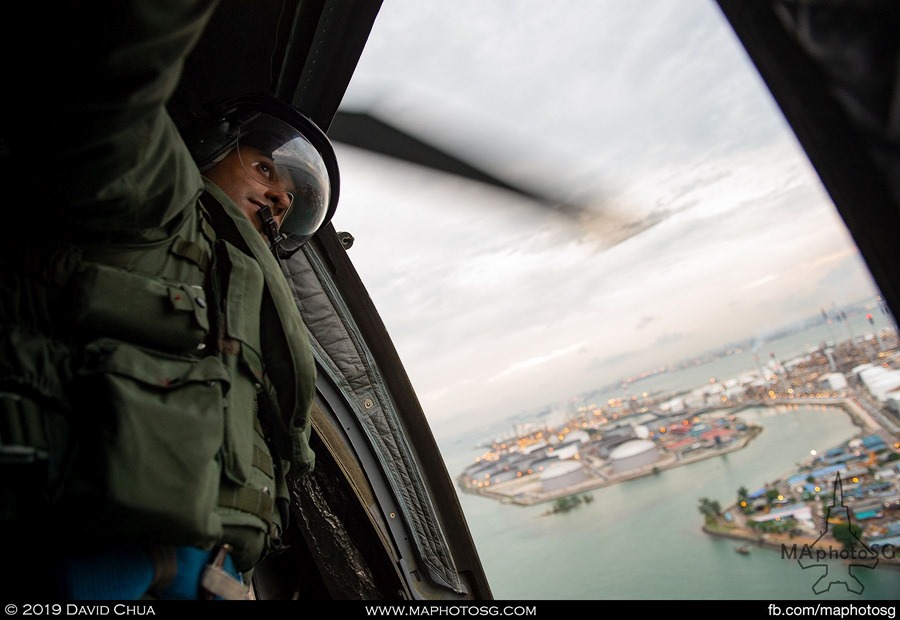
48. The Air Crew Specialist keeps a look out as the Chinook turns in towards the direction of Pulau Sudong.
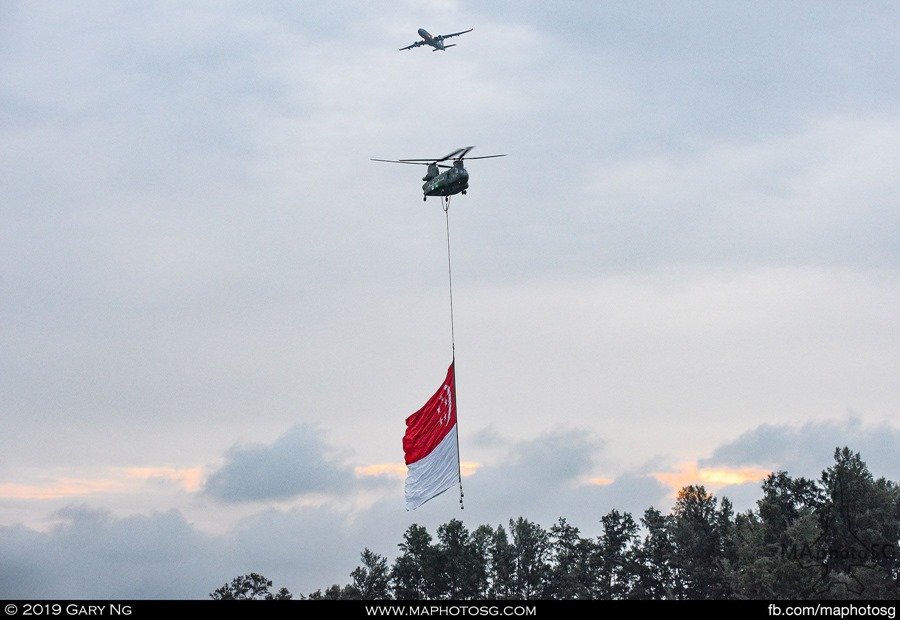
49. With the Airbus A330 MRTT circling overhead, the Chinook slows down while approaching Pulau Sudong.
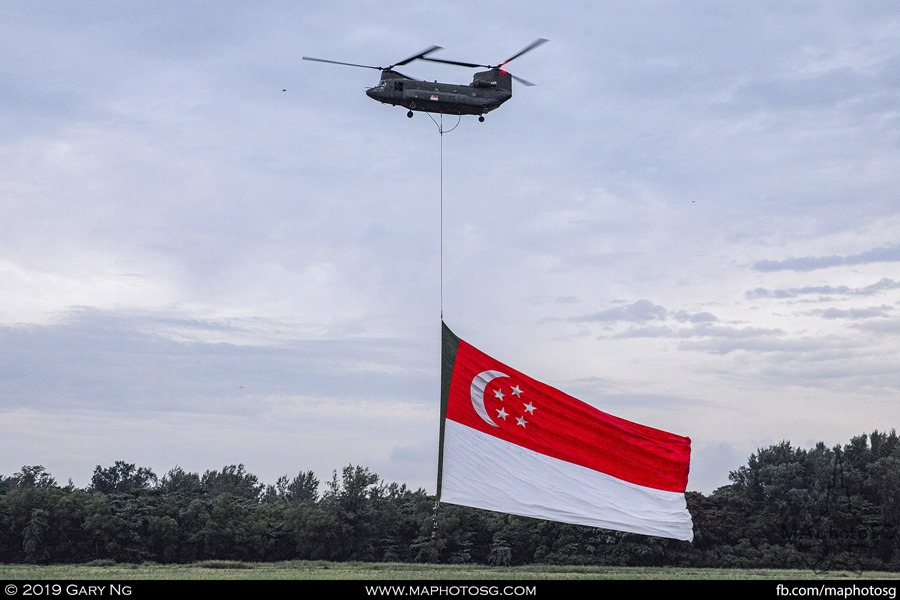
50. The ballasts will be dropped first before the flag is lowered down and the hooks released simultaneously by the pilots.
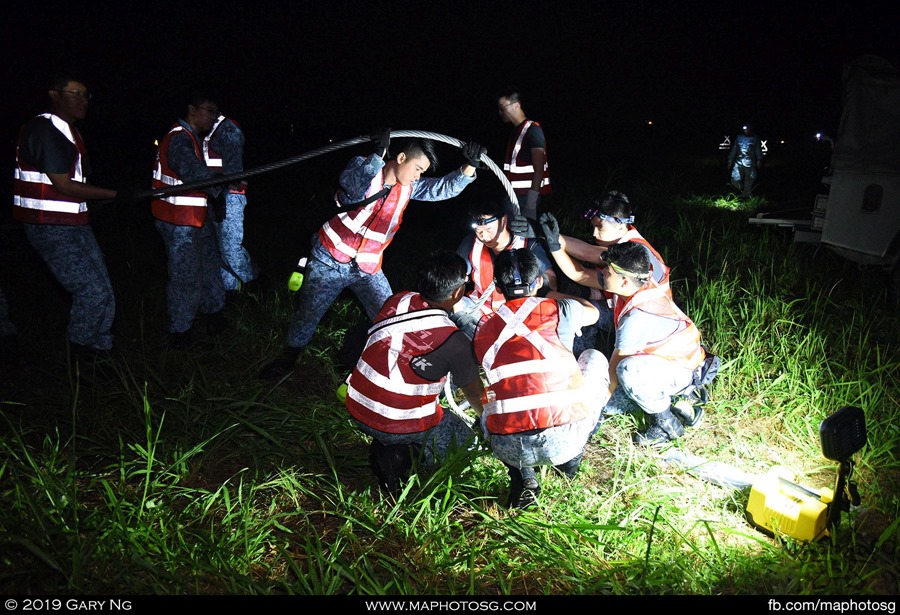
51. Working in the dark with only portable spotlights for illumination, the team proceeds to derig the flag.
While the smaller items can be loaded onto a vehicle, the flag and its cables have to be coiled up and manually brought out of the field.
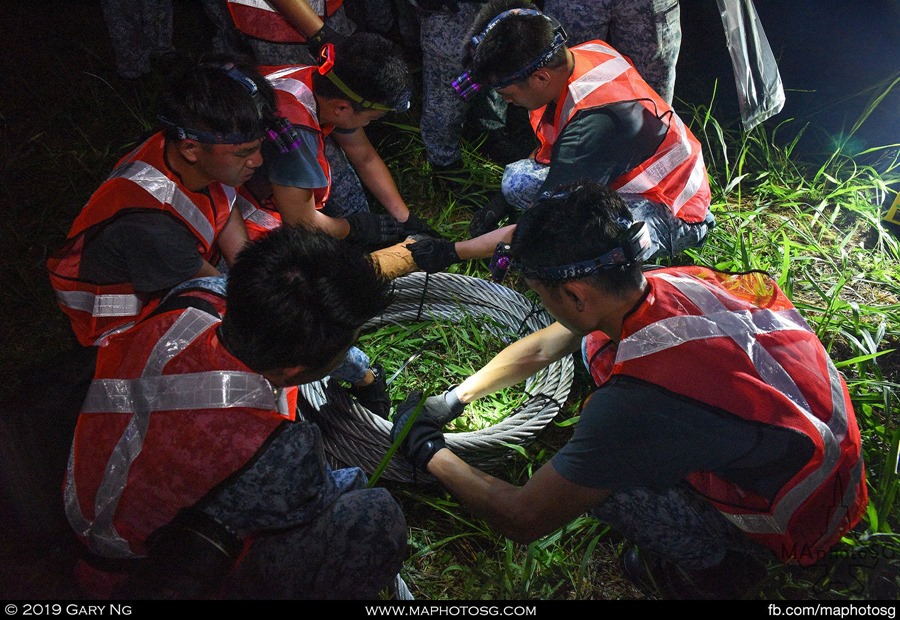
52. The 136 feet cable is securely strapped after coiling.
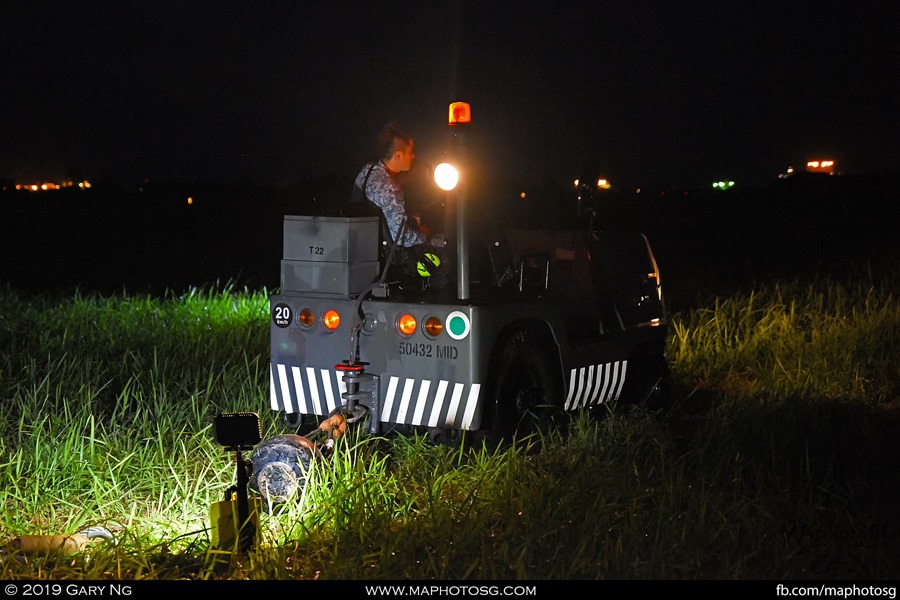
53. The ballasts will be towed out of the field by the tractors as the forklift is not able to navigate on rough terrain.
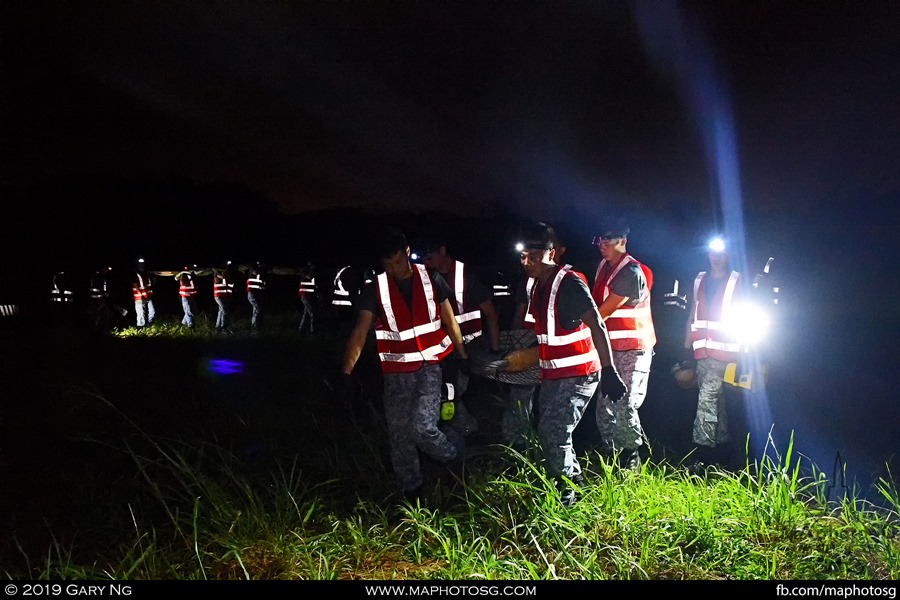
54. The flag is carefully brought out by the team, as they keep a close watch on the ground for uneven terrain or holes.
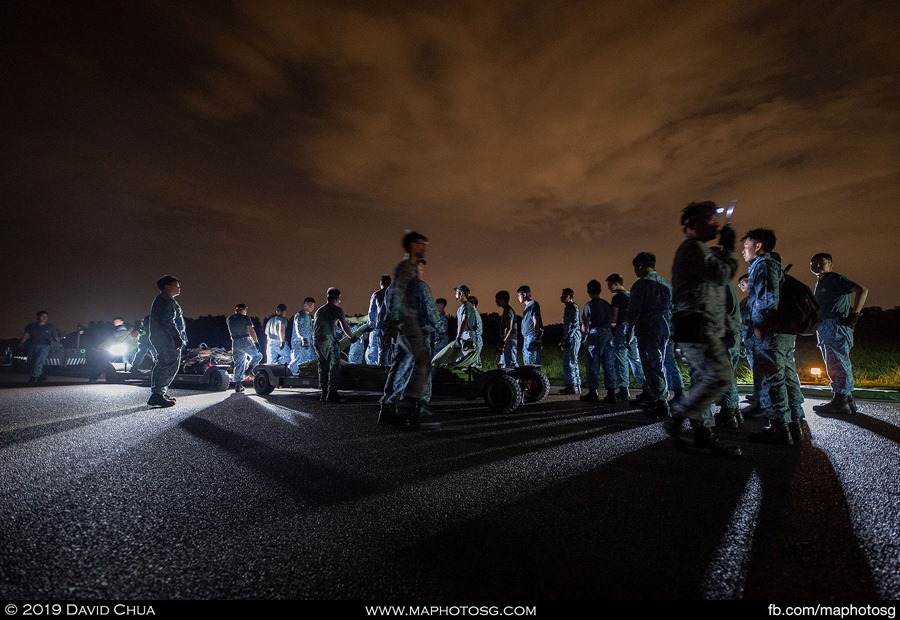
55. With all the flags and equipment ready for loading, the team waits for the Chinook which will pick up the first wave at about 2100 hours.
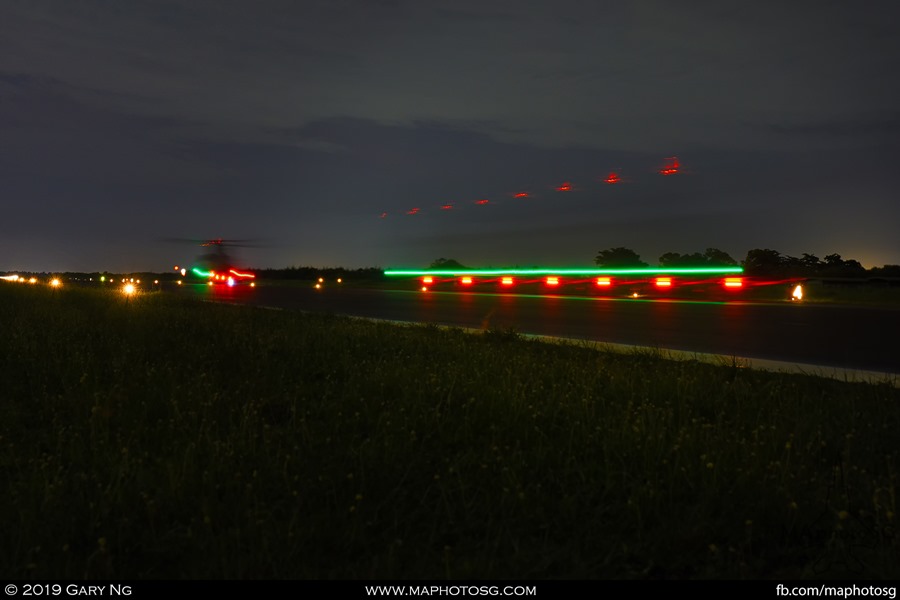
56. After landing, the Chinook taxis into position to prepare for a night hot loading of the flags and team.
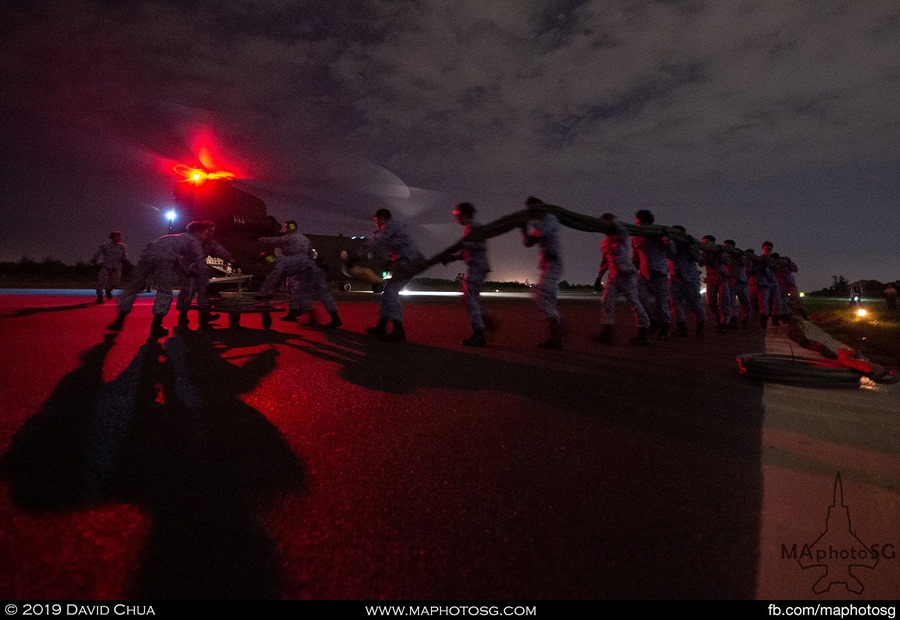
57. Hot loading of the first flag. A total of three flags will be brought back on the first wave.
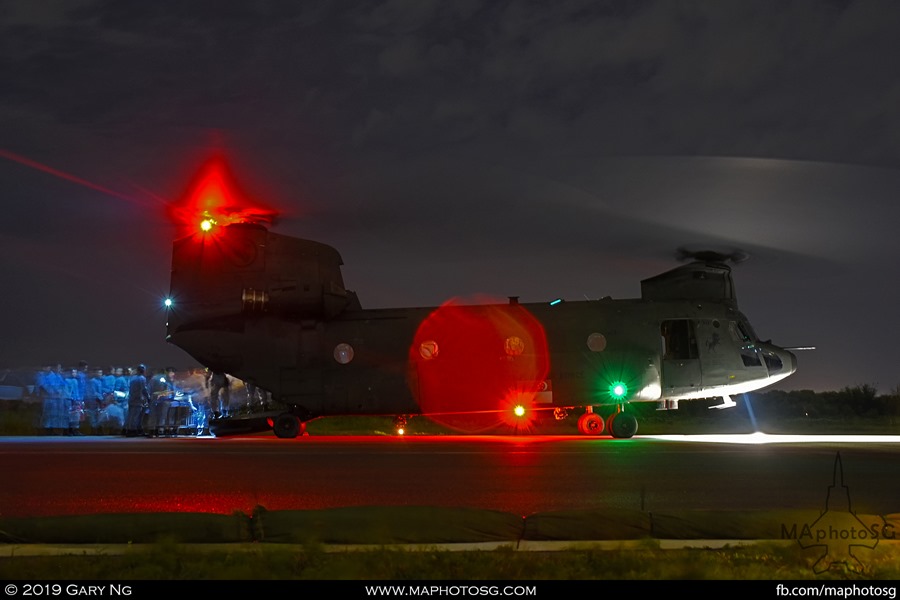
58. The Chinook keeps its engines and rotors running during a hot loading.
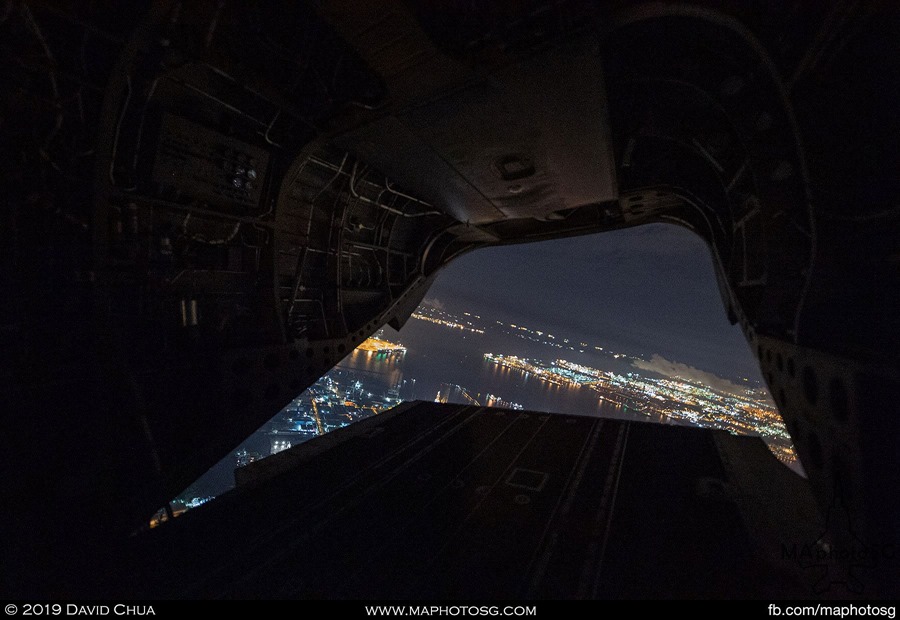
59. The Chinook flies over the mainland as it heads back to Sembawang Air Base with the first wave team.
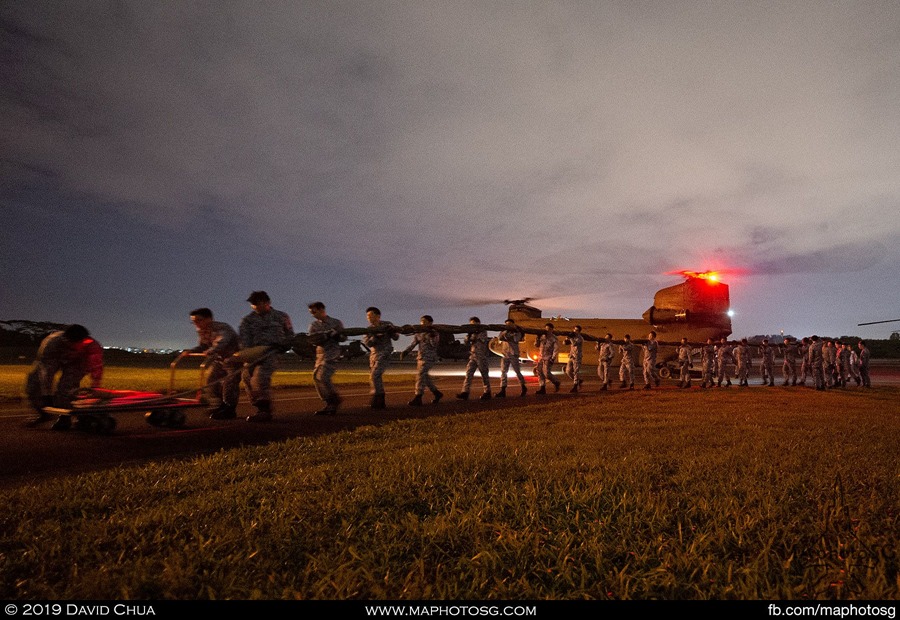
60. Upon the arrival at Sembawang Air Base, the team performs a hot unloading of the flags and equipment.
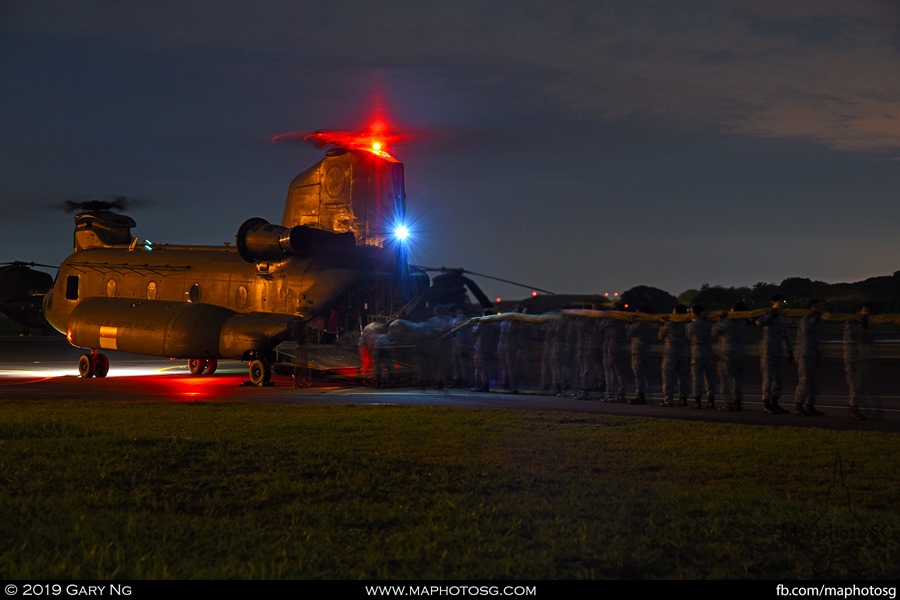
61. The Chinook will make a last flight back to Pulau Sudong to pick up the second wave of the team and remaining flag, before the entire flag deployment operation is concluded.
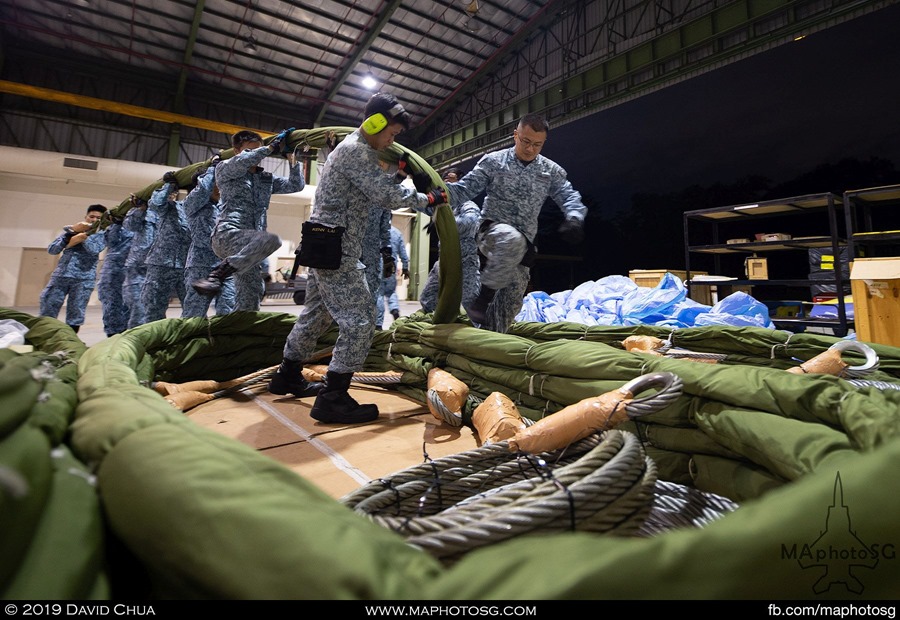
62. The flags and equipment are all securely stored back into the hangar, and come Tuesday morning, the entire process will be repeated again leading up to the next flypast.
Mission end time: 2300 hours
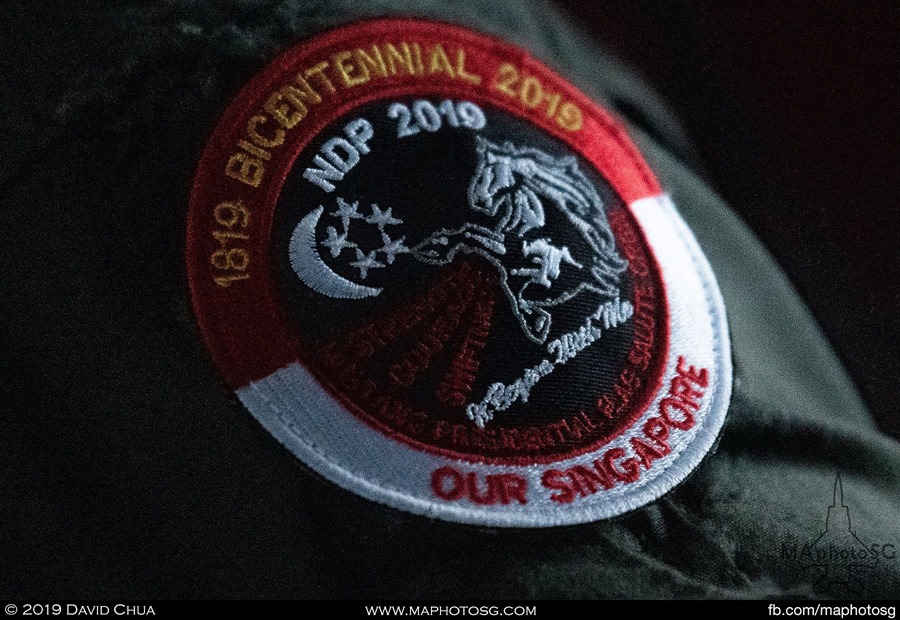
MAphotoSG would like to thank the airmen and airwomen of MPFSC and 127 Squadron for their hard work and dedication for every State Flag Flypast, and we also appreciate the time and patience they have given us over the few days spent with them. We also would like to give a special thanks to the Air Force Information Centre for facilitating us in the preparation of this article.

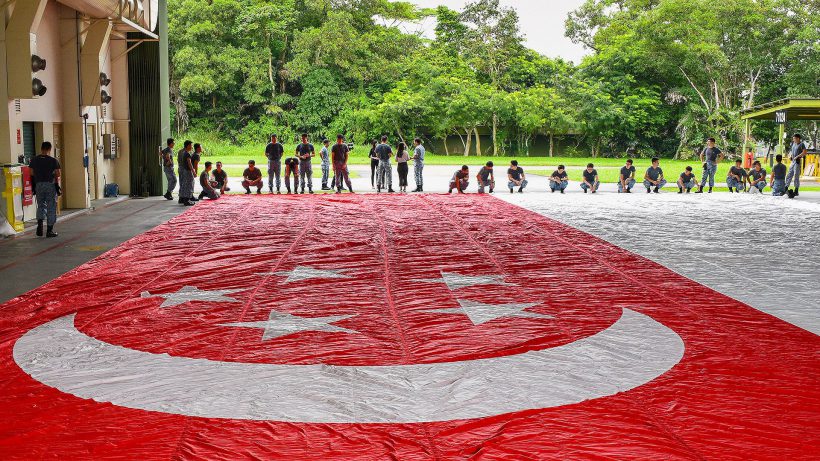
What a marvellous and dedicated duty by the entire team for a very patrotic task. I am so proud, as a Singaporean to read of the hard work that that these teams of active and NSmen put in for iur National Day. We should be proud thst we can count on these dedicated teams of Singaporeans to show the world how proud we are of our flsg and country. Majulah Singspura!